Petrographical and Mineralogical Characteristics of Magmatic Rocks in the Northwestern Siberian Traps Province, Kulyumber River Valley. Part I: Rocks of the Khalil and Kaya Sites
Abstract
:1. Introduction
2. Tectonic Structure
3. Brief Geology of the Area
4. Objects and Methods
5. Results
5.1. Volcanic Rocks
5.1.1. Structure of Tuff-Lava Sequence and Petrography of Volcanic Rocks
5.1.2. Geochemistry of Volcanic Rocks
5.1.3. Isotope Composition of Volcanic Rocks
5.2. Intrusive Rocks
5.2.1. General Characteristic of Intrusive Rocks
5.2.2. Petrography of Intrusive Rocks
5.2.3. Chemical Composition of Intrusive Rocks
6. Discussion
6.1. Volcanic Rocks
6.2. Intrusive Rocks
6.3. Magmatic Evolution
7. Conclusions
- Geochemical and mineralogical data on the volcanic rocks in the Khalil and Kaya sites of the Kulyumber area allow their attribution to the Syverminsky, Gudchikhinsky, Khakanchansky, Tuklonsky and Nadezhdinsky formations. No rocks of the Ivakinsky formation were found in the studied area, which pinches out to the south from the Norilsk area. Thus, volcanic rocks of the Syverminsky formation overlap sub-concordantly the terrigenous deposits of the Tunguska Group.
- The composition of the Guchikhinskiy formation changes from the Norilsk district to the Kulyumber river valley: rocks are enriched in alkalis (up to 4.3 wt.% in total) in the Khalil area (in comparison with 1.15% in the Norilsk area) and depleted in the Th and U contents, respectively. These data reflect an evolution of the formation within the Norilsk–Igarka paleo rift zone.
- Four intrusive complexes were recognized within the Khalil area, including Ergalakhsky, Kureysky, Katangsky and Norilsk. The latter is represented by one dyke-like body of gabbro-dolerites attributed to the Norilsk complex on the basis of it low TiO2 and high Cr contents although the (U/Nb)n ratio is low.
Author Contributions
Funding
Acknowledgments
Conflicts of Interest
References
- Coffin, M.F.; Eldholm, O. Scratching the surface: Estimating dimensions of Large igneous provinces. Geophysics 1993, 21, 515–518. [Google Scholar] [CrossRef]
- Coffin, M.F.; Eldholm, O. Large igneous provinces. Crustal structure, dimensions and external consequences. Rev. Geoghys. 1994, 32, 1–36. [Google Scholar] [CrossRef]
- Ernst, R.E. Large Igneous Provinces; Cambridge University Press: Cambridge, UK, 2014; Volume 7. [Google Scholar]
- Campbell, I. Mantle Plume, Planetary. In Encyclopedia of Astrobiology; Gargaud, M., Amilis, R., Cernicharo Quintanilla, J., Cleaves, H.J., Irvin, W.M., Piniti, D.L., Viso, M., Eds.; Springer: Berlin/Heidelberg, Germany, 2015. [Google Scholar] [CrossRef]
- Jonesa, T.D.; DaviesaI, D.R.; Campbell, I.; Wilsonb, C.R.; Kramerc, S.C. Do mantle plumes preserve the heterogeneous structure of their deep-mantle source? Earth Planet. Sci. Lett. 2016, 434, 10–17. [Google Scholar] [CrossRef] [Green Version]
- Zolotukhin, V.V.; Vilensky, A.M.; VasilievYu, R.; Dyuzhikov, O.A. Magnesium Basic Rocks of Western Part of the Siberian Platform and Problems of Nickel Potential; Nauka: Novosibirsk, Russia, 1984; p. 208. (In Russian) [Google Scholar]
- Zolotukhin, V.V.; Vilensky, A.M.; Dyuzhikov, O.A. Basalts of the Siberian Platform; Nauka: Novosibirsk, Russia, 1986; p. 245. (In Russian) [Google Scholar]
- Godlevsky, M.N. Traps and Ore-Bearing Intrusion; Gosgeoltekhizdat: Moscow, Russia, 1959; p. 61. (In Russian) [Google Scholar]
- Egorov, V.N.; Sukhanova, E.N. Talnakh ore-bearing intrusion in NW Siberian platform. Explor. Prot. Nat. Resour. 1963, 1, 17–21. (In Russian) [Google Scholar]
- Dyuzhikov, O.A.; Distler, V.V.; Strunin, B.M.; Mkrtychyan, A.K.; Sherman, M.L.; Sluzhenikin, S.F.; Lurye, A.M. Geology and Ore Potential of the Norilsk Ore District; Nauka: Moscow, Russia, 1988; p. 238. (In Russian) [Google Scholar]
- Distler, V.V.; Grokhovskaya, T.L.; Evstigneeva, T.L.; Sluzhenikin, S.F.; Filimonova, A.A.; Dyuzhikov, O.A. Petrology of Magmatic Sulfide Ore Formation; Nauka: Moscow, Russia, 1988; p. 232. (In Russian) [Google Scholar]
- Likhachev, A.P. Kharaelakh intrusion and its Pt-Cu-Ni ores. Rudy I Met. 1998, 3, 48–62. (In Russian) [Google Scholar]
- Likhachev, A.P. Conditions of Cu-Ni deposits’ formation. Sov. Geol. 1982, 6, 31–46. (In Russian) [Google Scholar]
- Lul’ko, V.A.; Fedorenko, V.A.; Distler, V.V.; Sluzhenikin, S.F.; Kunilov, V.E.; Stekhin, A.I.; Ryabikin, V.A.; Simonov, O.N.; Zen’ko, T.E. Geology and Oredeposits of the Norilskregion; Guidebook VII IPS: Moscow-Norilsk, Russia, 1994; Volume 43. [Google Scholar]
- Likhachev, A.P. Platinum–Copper–Nickel and Platinum Deposits; Eslan: Moscow, Russia, 2006; p. 496. (In Russian) [Google Scholar]
- Ryabov, V.V.; Shevko, A.Y.; Gora, M.P. Trap Magmatism and Ore Formation in the Siberian Norilsk Region; Springer: Dordrecht, The Nederland, 2014; Volume 1–2. [Google Scholar]
- Krivolutskaya, N.A. Siberian Traps and Pt-Cu-Ni Deposits in the Norilsk Area; Springer: Amsterdam, The Netherland, 2016; p. 361. [Google Scholar]
- Black, B.A.; Elkins-Tanton, L.T.; Rowe, M.C.; Peate, I.U. Magnitude and consequence and volatile realise from the Siberian traps. Earth Planet Sci. Lett. 2012, 317–318, 363–373. [Google Scholar] [CrossRef]
- Schmidt, A.; Elkins-Tanton, L. Volcanism and Global Environmental Change, Special volume; Cambridge University Press: Cambridge, UK, 2015. [Google Scholar]
- Burgess, S.D.; Bowring, S.; Shen, S. High-precision timeline for Earth’s most sivere condition. In Proceedings of the National Academy of Science; National Academy of Sciences: Washington, DC, USA, 2014; Volume 111, pp. 3316–3321. [Google Scholar] [CrossRef] [Green Version]
- Zolotukhin, V.V.; Vasil’ev, Y.R.; Dyuzhikov, O.A. Diversity of Traps and Initial Magmas: A Case of the Siberian Platform; Nauka: Novosibirsk, Russia, 1978; p. 289. (In Russian) [Google Scholar]
- Zolotukhin, V.V.; Al’mukhamedov, A.I. Basalts of the Siberian platform: Composition and mechanism of formation. In Traps of Siberia and Deccan: Similarities and differences; Nauka: Novosibirsk, Russia, 1991; pp. 7–39. (In Russian) [Google Scholar]
- Oleynikov, B.V.; Tomshin, M.D. Evolution of basic intrusive magmatism of the Siberian platform in time. In Traps of Siberia and Deccan: Similarities and Differences; Nauka: Novosibirsk, Russia, 1991; pp. 39–63. (In Russian) [Google Scholar]
- Dobretsov, N.L.; Vernikovsky, V.A. Mantle Plumes and Their Geologic Manifestations. Intern. Geol. Rev. 2001, 43, 771–787. [Google Scholar] [CrossRef]
- Dobretsov, N.L.; Borisenko, A.S.; Izokh, A.E.; Zhmodik, S.M. Termochemical model of Permo-Triassic plume of Euroausia as a basement for genesis understanding and prospecting of copper-nickel, noble- and rare metals deposits. Rus. Geol. Geophys. 2010, 51, 1159–1180. [Google Scholar] [CrossRef]
- Dobretsov, N.L.; Borisenko, A.S.; Izokh, A.E. Termochemical deep mantle plums as a source of ore potencial on the planet. Nauka Iz Pervykh Ruk 2011, 6, 37–43. (In Russian) [Google Scholar]
- Sobolev, A.V.; Kuzmin, D.V.; Krivolutskaya, N.A. Petrology of primary melts and mantle sources of the Siberian trap province. Petrology 2009, 17, 276–310. [Google Scholar] [CrossRef] [Green Version]
- Sobolev, A.V.; Slutsky, A.B. Composition and Crystallization Conditions of the Parental Melt of the Siberian Meymechites in Connection with the General Problem of Ultrabasic Magmas. Geol. Geophys. 1984, 12, 97–110. (In Russian) [Google Scholar]
- Lightfoot, P.C.; Naldrett, A.J.; Gorbachev, N.S.; Doherty, W.; Fedorenko, V.A. Geochemistry of the Siberian traps of the Norilsk area: With implications for the relative contributions of crust and mantle to flood basalts. Contrib. Mineral. Petrol. 1990, 104, 631–644. [Google Scholar] [CrossRef]
- Wooden, J.L.; Czamanske, G.K.; Bouse, R.M.; King, B.-S.W.; Kknight, R.J.; Siems, D.F. Isotopic and trace-element constraints on mantle and crustal contributions to Siberian continental flood basalts, Norilsk area, Siberia. Geochim. Cosmochim. Acta 1993, 57, 3677–3704. [Google Scholar] [CrossRef]
- Hawkesworth, C.J.; Lightfoot, P.C.; Fedorenko, V.A.; Balck, S.; Naldrett, A.J.; Doherty, W.; Gorbachev, N.S. Magma differentiation and mineralization in the Siberian flood basalts. Lithos 1995, 34, 61–88. [Google Scholar] [CrossRef]
- Lightfoot, P.C.; Naldrett, A.J.; Gorbachev, N.S.; Fedorenko, V.A.; Howkesworth, C.J.; Hergt, J.; Doherty, W. Chemostratigraphy of Siberian Trap Lavas, Noril’sk District: Implication for the Source of Flood Basalt Magmas and their Associated Ni-Cu Mineralization. In Proceeding of the Sudbary–Noril’sk Symposium; Ontario Geological Survey: Greater Sudbury, ON, Canada, 1994; pp. 283–312. [Google Scholar]
- Al’mukhamedov, A.I.; Medvedev, A.Y.; Zolotukhin, V.V. Evolutions of Permo-Triassic basalts of the Siberian Platform in time and space. Petrology 2004, 12, 339–353. [Google Scholar]
- Fedorenko, V.A.; Czamanske, G. Results of New Field and Geochemical Studies of the Volcanic Rocks of the Maymecha–Kotuy Area, Siberian Flood-Basalt Province, Russia. Intern. Geol. Rev. 1997, 39, 479–531. [Google Scholar] [CrossRef]
- Arndt, N.T.; Chauvel, C.; Czamanske, G.; Fedorenko, V.A. Two Mantle Sources, Two Plumbing Systems: Tholeiitic and Alkaline Magmatism of the Maymecha River Basin, Siberian Flood Volcanic Province. Contrib. Miner. Pet. 1998, 133, 279–313. [Google Scholar] [CrossRef]
- Sobolev, A.V.; Hofmann, A.J.; Kuzmin, D.V.; Yaxley, J.M.; Arndt, N.T.; Chung, S.L.; Danyushevsky, L.V.; Elliot, T.; Frey, F.A.; Garcia, M.O.; et al. The amount of Recycled Crust in Sources of Mantle-Derived Melts. Science 2007, 316, 412–417. [Google Scholar] [CrossRef]
- Sobolev, A.V.; Sobolev, S.V.; Kuzmin, D.V.; Malitch, K.N.; Petrunin, A.G. Siberian meimechites: Origin and relation to flood basalts and kimberlites. Rus. Geol. Geophys. 2009, 50, 999–1033. [Google Scholar] [CrossRef]
- Hawkwsworth, C.J.; Lightfoot, P.C.; Hergt, J.M.; Naldrett, A.J.; Gorbachev, N.S.; Fedorenko, V.A.; Doherty, W. Remobilisation of the continental lithosphere by a mantle plume: Trace element, ans Sr-, Nd- and Pb isotope evidence from picritic and tholeiitic lavas of the Noril’sk district, Siberian trap. Contrib. Mineral. Petrol. 1993, 114, 171–188. [Google Scholar]
- Krivolutskaya, N.A.; Ariskin, A.A.; Sluzhenikin, S.F.; Turovtsev, D.M. Geochemical thermometry of rocks of the Talnakh intrusion: Assessment of the melt composition and the crystallinity of the parental magma. Petrology 2001, 9, 389–414. [Google Scholar]
- Krivolutskaya, N.A. Formation of PGE-Cu-Ni deposits in the process of evolution of flood basalt magmatism in the Norilsk region. Geol. Ore Depos. 2011, 53, 303–339. [Google Scholar] [CrossRef]
- Malitch, K.N.; Badanina, I.Y.; Romanov, A.P.; Sluzhenikin, S.F. U-Pb age and Hf-Nd-Sr-Cu-S isotope systematics of the Binyuda and Dyumtaley ore-bearing intrusions (Taimyr, Russia). Lithosphera 2016, 16, 107–128. (In Russian) [Google Scholar]
- Malitch, K.N.; Belousova, E.A.; Griffin, W.L.; Badanina, I.Y.; Latypov, R.M.; Sluzhenikin, S.F. Chapter 7. New insights on the origin of ultramafic-mafic intrusions and associated Ni-Cu-PGE sulfide deposits of the Norilsk and Taimyr provinces, Russia: Evidence from radiogenic and stable isotope data. In Processes and Ore Deposits of Ultramafic-Mafic Magmas through Space and Time; Elsevier: Chennai, India, 2018; pp. 197–238. [Google Scholar]
- Petrov, O.V. (Ed.) Isotope Geochemistry of the Norilsk Deposits; VSEGEI: St.Peterbourg, Russia, 2017; p. 346. (In Russian) [Google Scholar]
- Krivolutskaya, N.; Gongalsky, B.; Kedrovskaya, T.; Kubrakova, I.; Tyutyunnik, O.; Chikatueva, V.; Bychkova, Y.; Kovalchuk, E.; Kononkova, N.; Yakushev, A. Geology of the Western Flanks of the Oktyabr’skoe Deposit, Norilsk District, Russia: Evidence of a Closed Magmatic System. Miner. Depos. 2019, 54, 611–630. [Google Scholar] [CrossRef]
- Romanov, A.P.; Kurbatov, I.I.; Malitch, K.N.; Snisar, S.G.; Borodina, E.V.; Erykalov, S.P. The Resource Potential of the Platinum Metals in Western Taimyr. Platin. Russ. 2011, 7, 135–160. (In Russian) [Google Scholar]
- Tomshin, M.D.; Kopylova, A.G.; Vasilyeva, A.E. Geochemical and isotope characteristics of intrusive traps in the Eastern Siberian Platform. In Geoconference on Science and Technologies in Geology, Exploration and Mining; Nauka: Novosibirsk, Russia, 2014; Volume 1, pp. 113–120. (In Russian) [Google Scholar]
- Krivolutskaya, N.; Krasilnikov, A.; Gongalsky, B.; Yakushev, A.; Svirskaya, N. Structure and Geochemical Features of the Volcanic Rocks in the Tunguska Syneclise (Siberian Trap Province). IOP Conf. Ser. Earth Environ. Sci. 2019, 362, 012090. [Google Scholar] [CrossRef] [Green Version]
- Malitch, N.S.; Grinson, A.S.; Tuganova, E.V.; Chernyshev, N.M. Rifting of the Siberian platform. In Proceedings of the 28th Session of International Geological Congress, Tectonic Processes, Washington, DC, USA, 4–14 August 1984; Nedra: Moscow, Russia, 1988; pp. 184–193. [Google Scholar]
- Dolgal, A.S. Realization of V.N. Strakhov ideas in interpretation of geopotential fields. In Strakhov as Geophysics and Mathematic; Academician, V.N., Ed.; Nauka: Moscow, Russia, 2012; pp. 55–78. (In Russian) [Google Scholar]
- Krivolutskaya, N.; Latyshev, A.; Dolgal, A.; Gongalsky, B.; Makareva, E.; Makarev, A.; Svirskaya, N.; Bychkova, Y.; Yakushev, A.; Asavin, A. Unique PGE–Cu–Ni Norilsk Deposits, Siberian Trap Province: Magmatic and Tectonic Factors in Their Origin. Minerals 2019, 9, 66. [Google Scholar] [CrossRef] [Green Version]
- Kamo, S.L.; Czamanske, G.K.; Amelin, Y. Rapid eruption of Siberian flood-volcanic rocks and evidence for coincidence with the Permian-Triassic boundary and mass extinction at 251 Ma. Earth Plan. Sci. Let. 2003, 214, 75–91. [Google Scholar] [CrossRef]
- Balk, P.I.; Dolgal, A.S.; Pugin, A.V.; Michurin, A.V.; Simanov, A.A.; Sharkhimullin, A.F. Effective algorithms for sourcewise approximation of geopotential fields. Izv. Phys. Solid Earth 2016, 52, 896–911. (In Russian) [Google Scholar] [CrossRef]
- Sherman, M.L. (Ed.) Geological Map 1:50000 Scale of the Central Part of the Norilsk District; Ministry of Geology: Moscow, Russia, 1981. (In Russian) [Google Scholar]
- Paderin, P.G. State Geological Map of Russian Federation, 1:1000000 Scale (New Version); R-(45)-47-Norilsk. Explanatory note 2000; VSEGEI: St Petersburg, Russia, 2000; p. 478. (In Russian) [Google Scholar]
- Lyul’ko, V.A. (Ed.) Legend for 1: 50 000 Scale Map, Norilsk Group; Geoinformmark: Moscow, Russia, 1993; p. 53. (In Russian) [Google Scholar]
- Karandashev, V.K.; Khvostikov, V.A.; Nosenko, S.V.; Burmii, Z. Stable highly enriched isotopes in routine analyses of rocks, soils, grounds, and sediments by ICP-MS. Inorg. Mater. 2017, 53, 1432–1441. [Google Scholar] [CrossRef]
- Sereda, E.; Belyatsky, B.; Krivolutskaya, N. Geochemistry and Geochronology of Southern Norilsk Intrusions, SW Siberian Traps. Minerals 2020, 10, 165. [Google Scholar] [CrossRef] [Green Version]
- Krivolutskaya, N. The problem of subdivision of volcanic rocks of trap formation of the Norilsk region. Doclady Earth Sci. 2011, 439, 1088–1092. [Google Scholar] [CrossRef]
- Streckeisen, A.; Zanettin, B.; Le Bas, M.J.; Bonin, B.; Bateman, P.; Bellieni, G.; Dudek, A.; Efremova, S.; Keller, J.; Lameyre, J.; et al. Igneous Rocks. A Classification and Glossary of Therms; Le Maitre, R.W., Ed.; Cambridge University Press: Cambridge, UK, 2002; p. 37. [Google Scholar]
- Hofmann, A.W. Chemical differentiation of the earth: The relationship between mantle, continental and ocean crust. Earth Planet Sci. Lett. 1988, 90, 297–314. [Google Scholar] [CrossRef] [Green Version]
- Krivolutskaya, N.; Sobolev, A.V.; Mikhailov, V.N.; Plechova, A.A.; Kostitsyn, Y.A.; Roschina, I.A.; Fekiacova, Z. Parental melt of the Nadezhdinsky Formation: Geochemistry, petrology and connection with Cu-Ni deposits (Norilsk area, Russia). Chem. Geol. 2012, 302–303, 87–105. [Google Scholar] [CrossRef]
- Datsenko, V.A.; Markov, F.B. (Eds.) Geological Map of the Norilsk Region and Adjacent Territories; R-45-XXIII, XXIV, Q-45; Nedra: Moscow, Russia, 1969; p. 81. (In Russian) [Google Scholar]
- Ryabov, V.V. Olivines and Their Petrological Significance; Nauka: Novosibirsk, Russia, 1992. (In Russian) [Google Scholar]
- Krivolutskaya, N.A.; Sobolev, A.V.; Snisar, S.G.; Gongalskiy, B.I.; Hauff, B.; Kuzmin, D.V.; Tushentsova, I.N.; Svirskaya, N.M.; Kononkova, N.N.; Schlychkova, T.B. Mineralogy, geochemistry and stratigraphy of the Maslovsky Pt–Cu–Ni sulfide deposit, Norilsk Region, Russia: Implications for relationship of ore-bearing intrusions and lavas. Miner. Depos. 2012, 47, 69–88. [Google Scholar] [CrossRef]
- Likhachev, A.P. Possibility of the self-enrichment by ore material and heavy sulfur isotope (34S) of mantle magmas forming Cu-Ni deposits and perspective places for ore discovering in the Norilsk area. Otechestvennaya Geol. 2019, 3, 1–18. (In Russian) [Google Scholar]
- Dneprovskaya, M.B.; Frenlel, M.Y.; Yaroshevsky, A.A. Quantitative ‘model of layering of the Talnakh intrusion. In Constrants of Models for Ore-Forming Systems; Nauka: Novosibirsk, Russia, 1987; pp. 96–106. (In Russian) [Google Scholar]
- Krivolutskaya, N.A.; Rudakova, A.V. Structure and geochemical characteristics of trap rocks from the Norilsk trough, northwestern Siberian Craton. Geochem. Int. 2009, 47, 675–698. [Google Scholar] [CrossRef]
- Fedorenko, V.A. Petrochemical series of the effusive rocks in the Norilsk area. Russ. Geol. Geophys. 1982, 6, 77–88. [Google Scholar]
- Sibik, S.; Edmonds, M.; Maclennan, J.; Svensen, H. Magmas erupted during the main puls of the Siberian trap volcanism were volatile-poor. J. Petrol. 2015, 56, 2089–2116. [Google Scholar] [CrossRef] [Green Version]
- Krivolutskaya, N.A.; Sobolev, A.V. Magmatic inclusions in olivines from intrusions of the Noril’sk region, Northwestern Siberian Platform: Evidences for primary melts. Doclady Earth Sci. 2001, 381, 393–398. [Google Scholar]
- Sobolev, A.V.; Arndt, N.T.; Krivolutskaya, N.A.; Kuzmin, D.V.; Sobolev, S.V. The origin of gases that caused the Permian-Triassic extinction. In Volcanism and Global Environmental Change; Schmidt, A., Fristad, K., Elkins-Tanton, L., Eds.; Cambridge University Press: Cambridge, UK, 2015; pp. 147–163. [Google Scholar]
- Rad’ko, V.A. Facies of Intrusive and Effusive Magmatism in the Norilsk Area; VSEGEI: St Petersburg, Russia, 2016; p. 225. (In Russian) [Google Scholar]
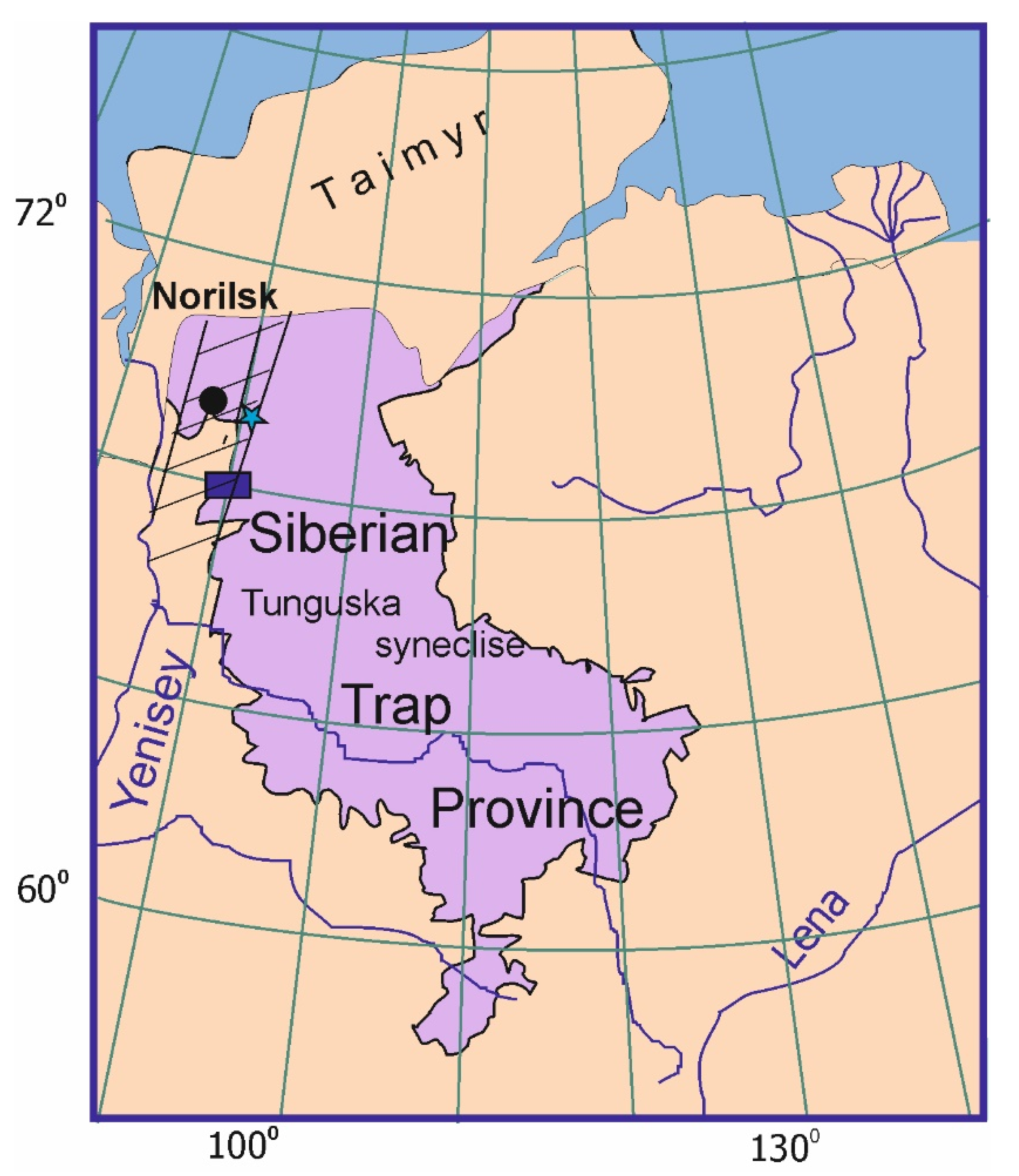
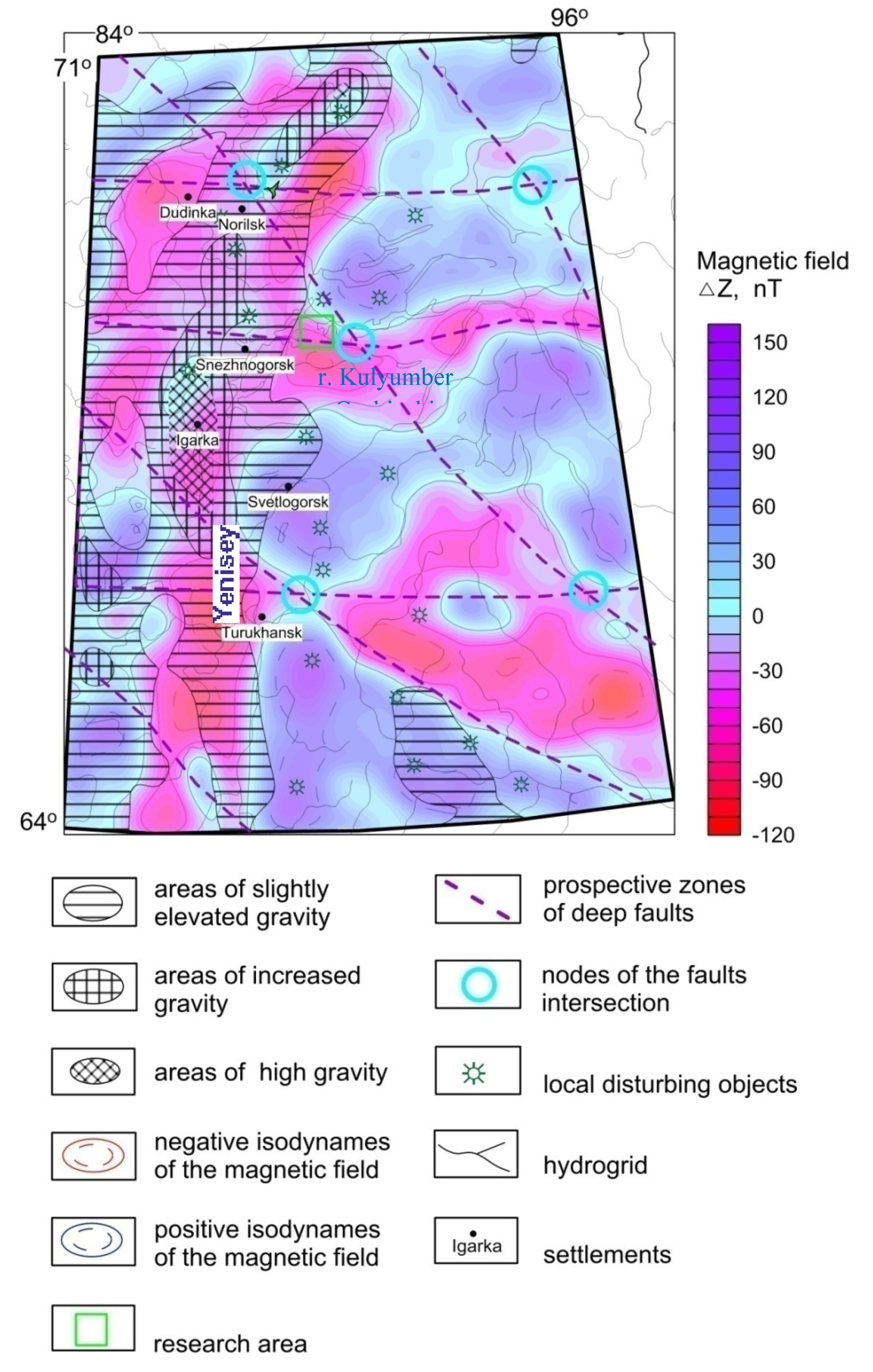
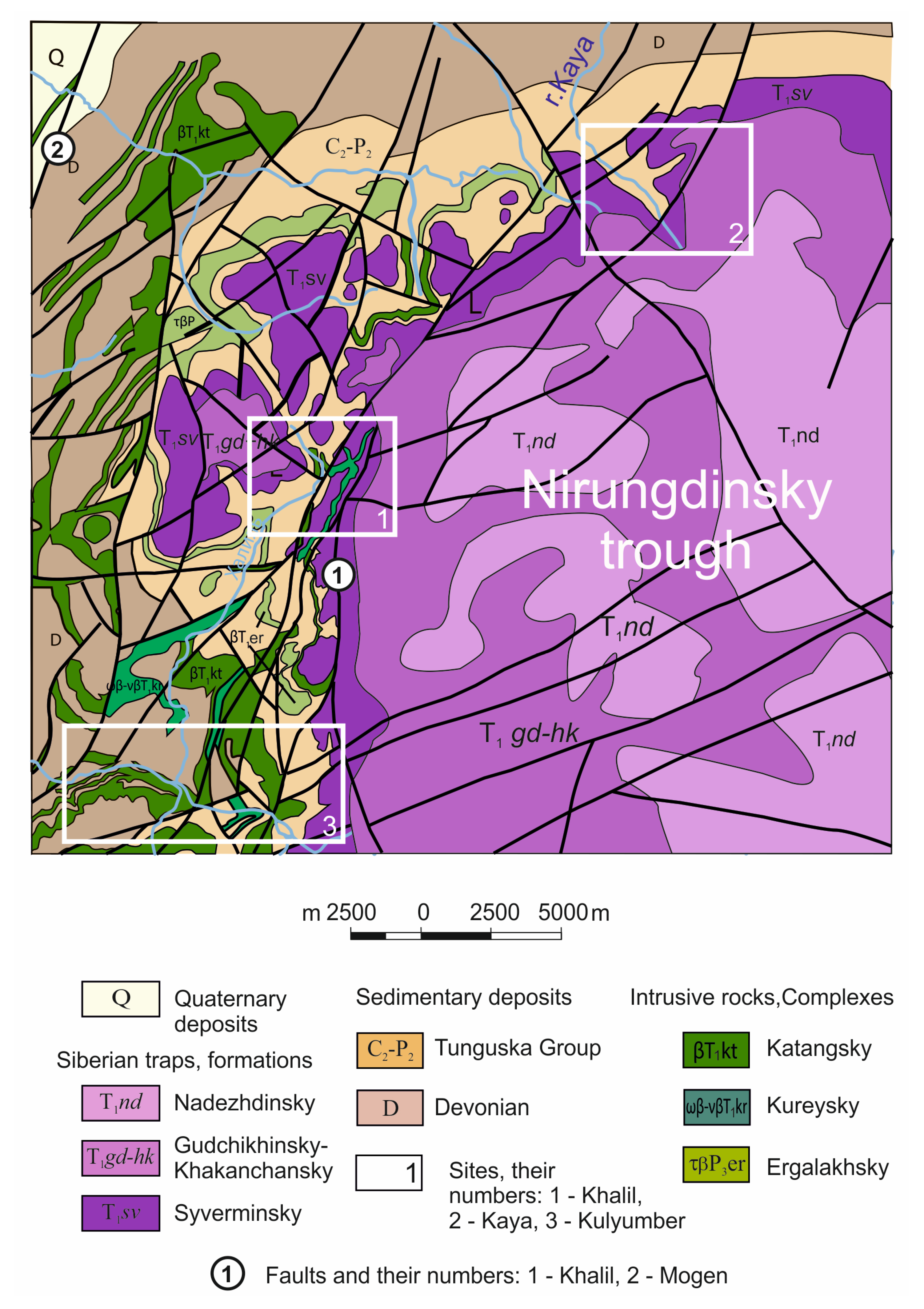
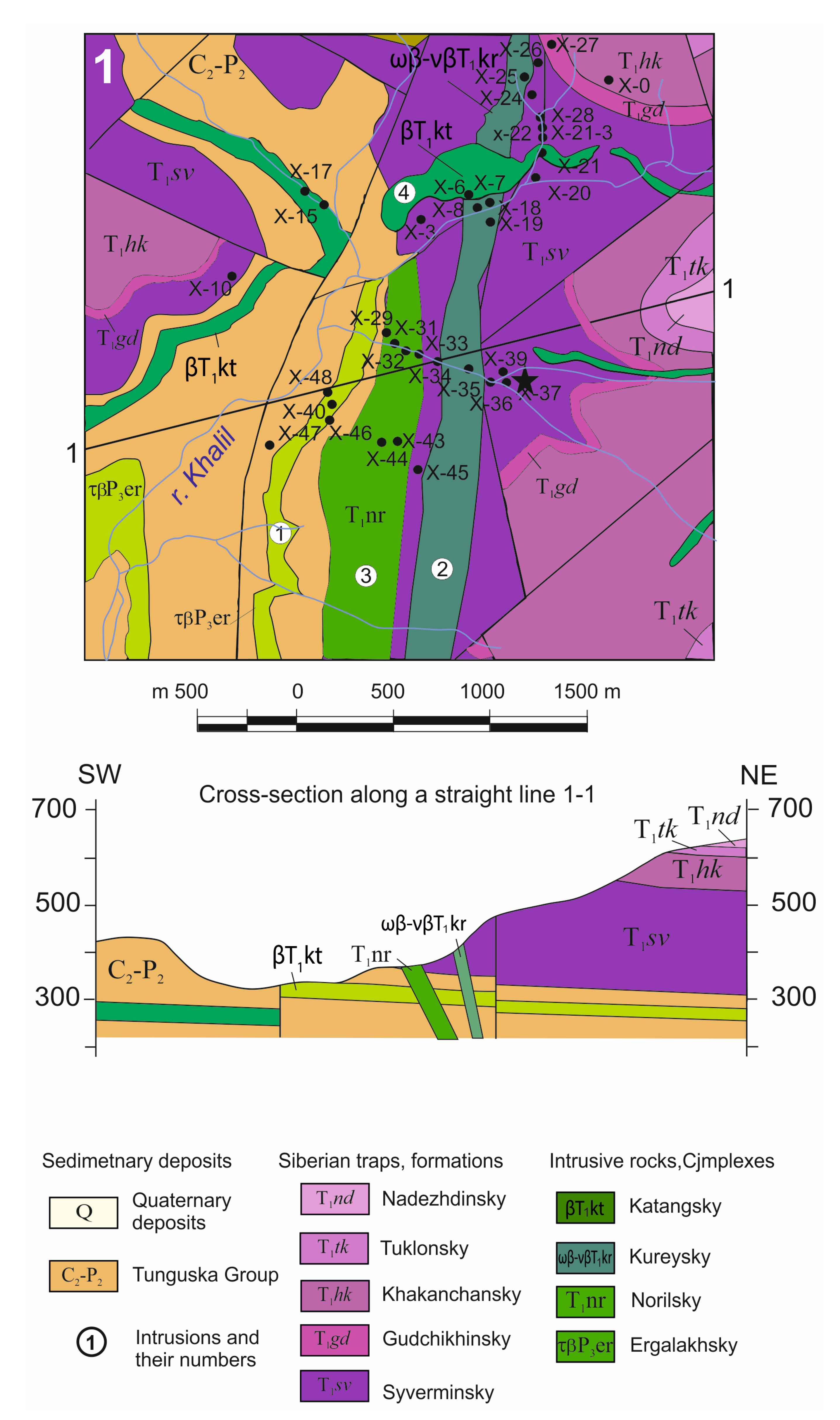
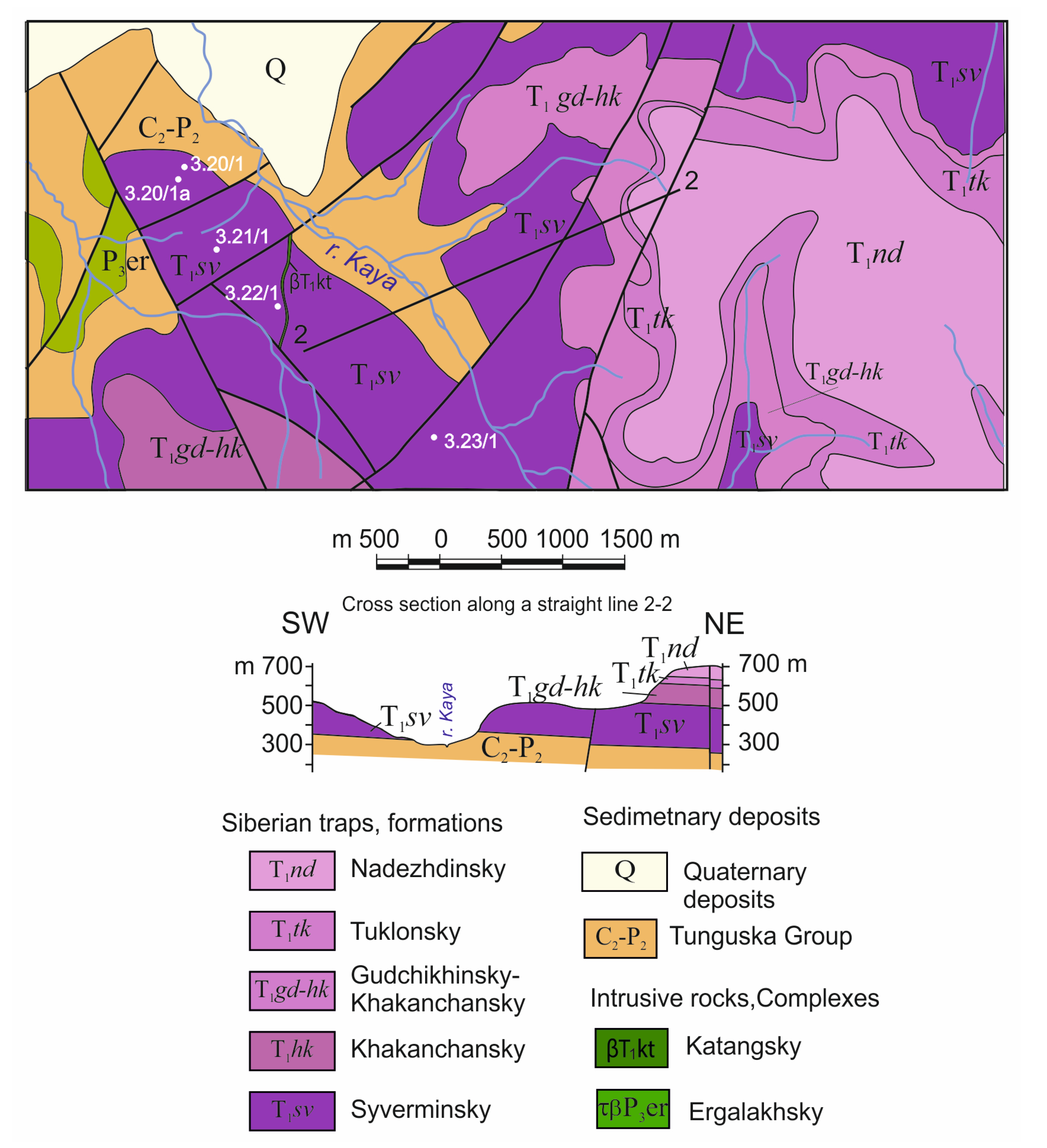
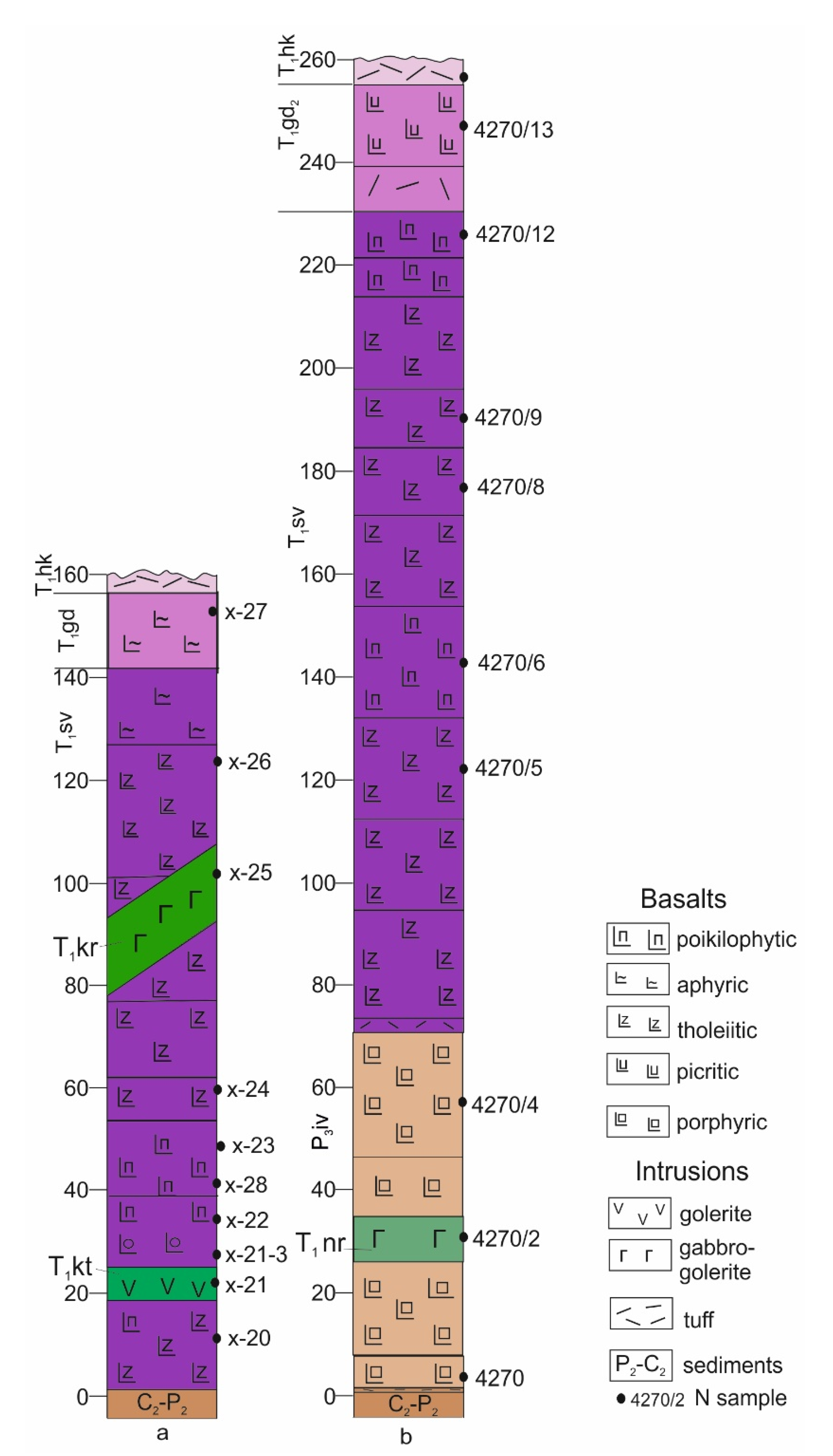
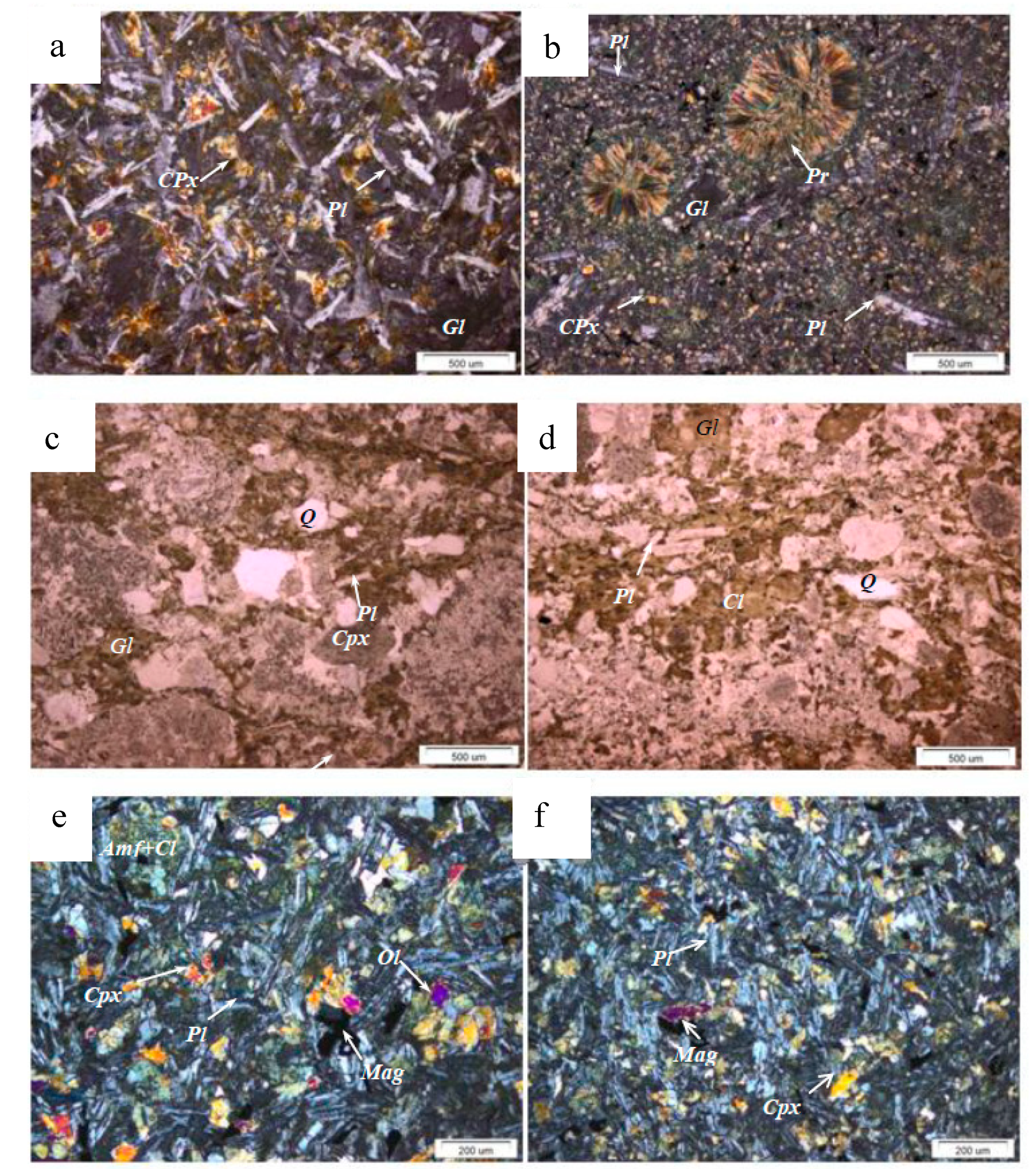
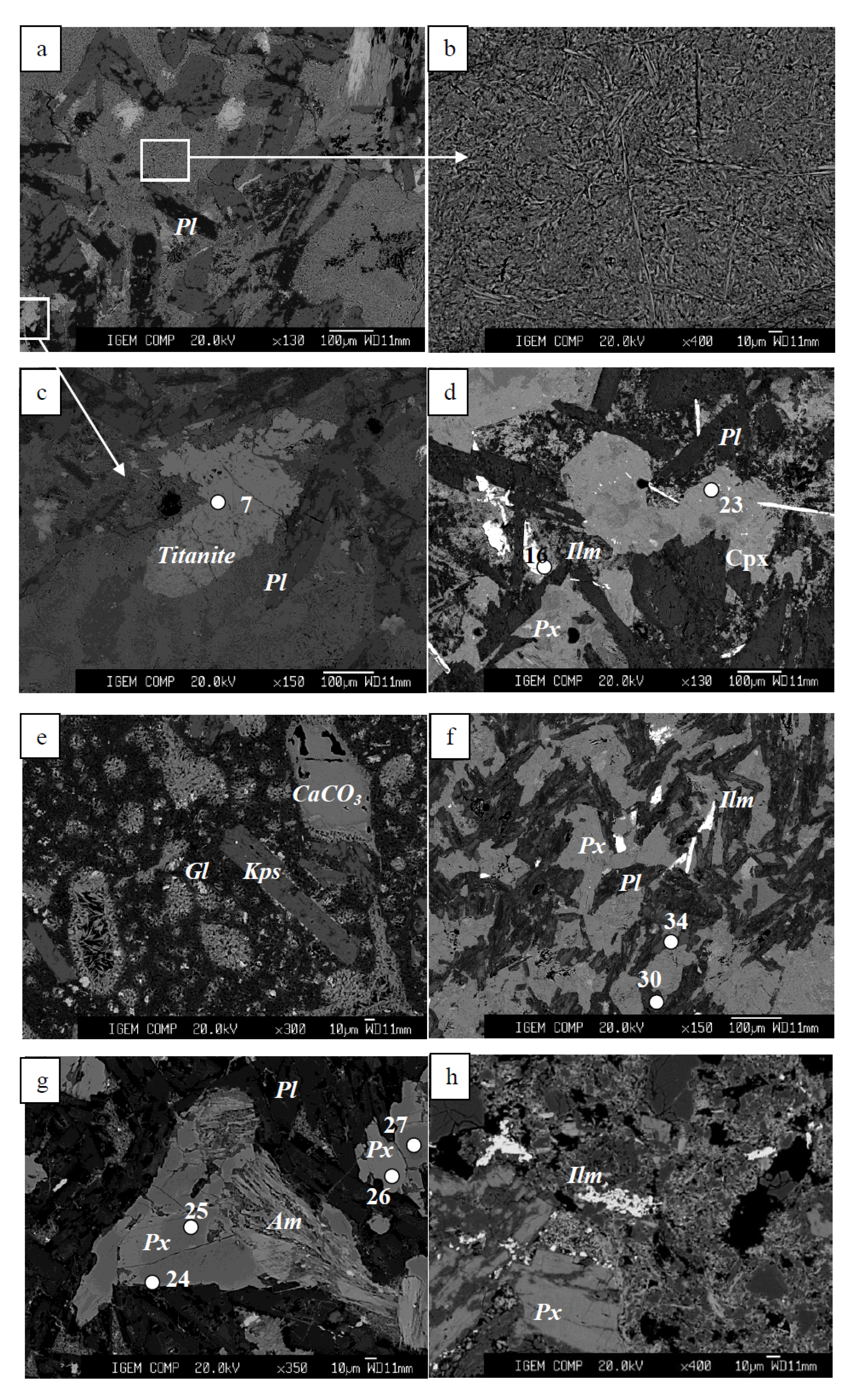
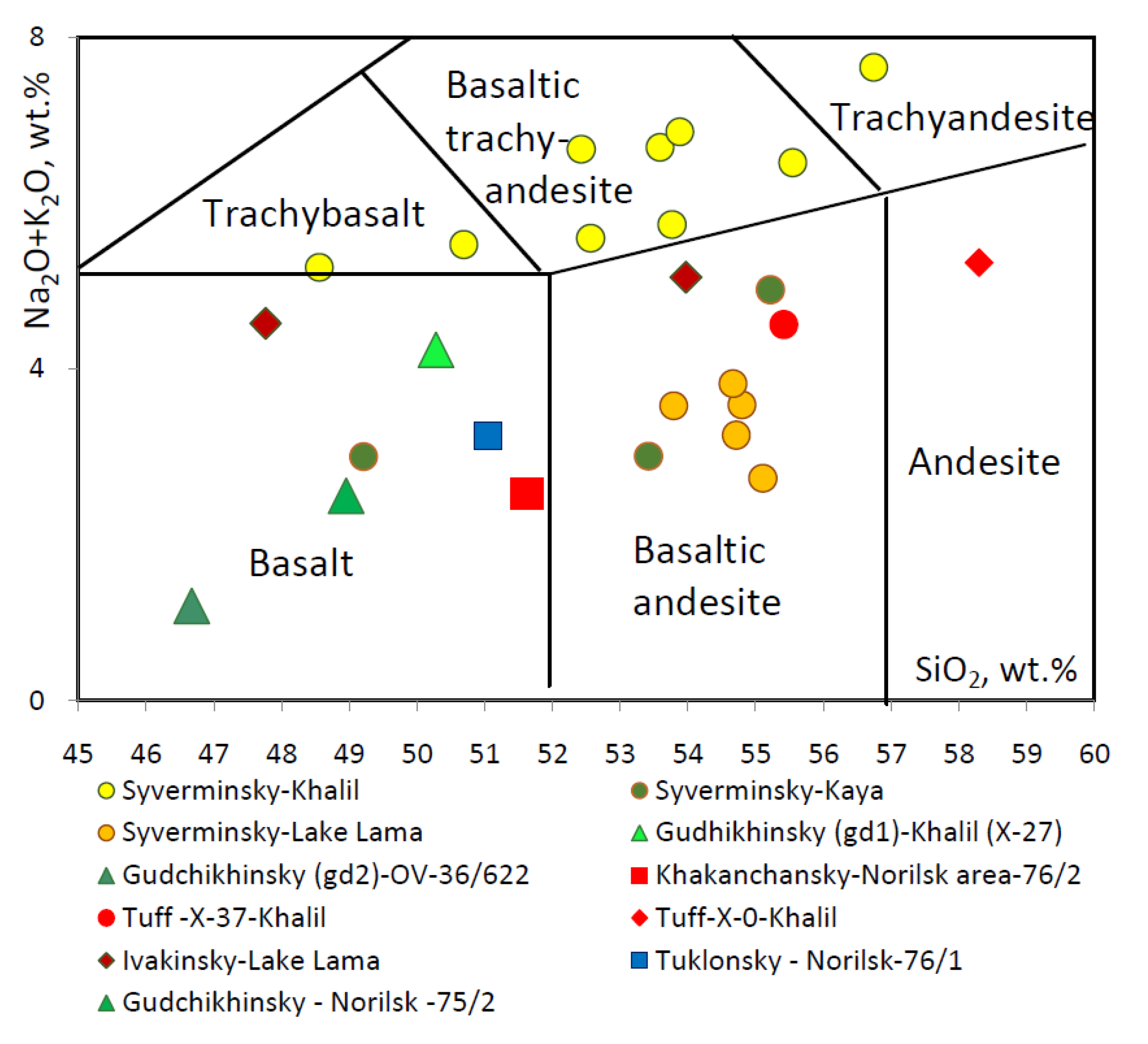
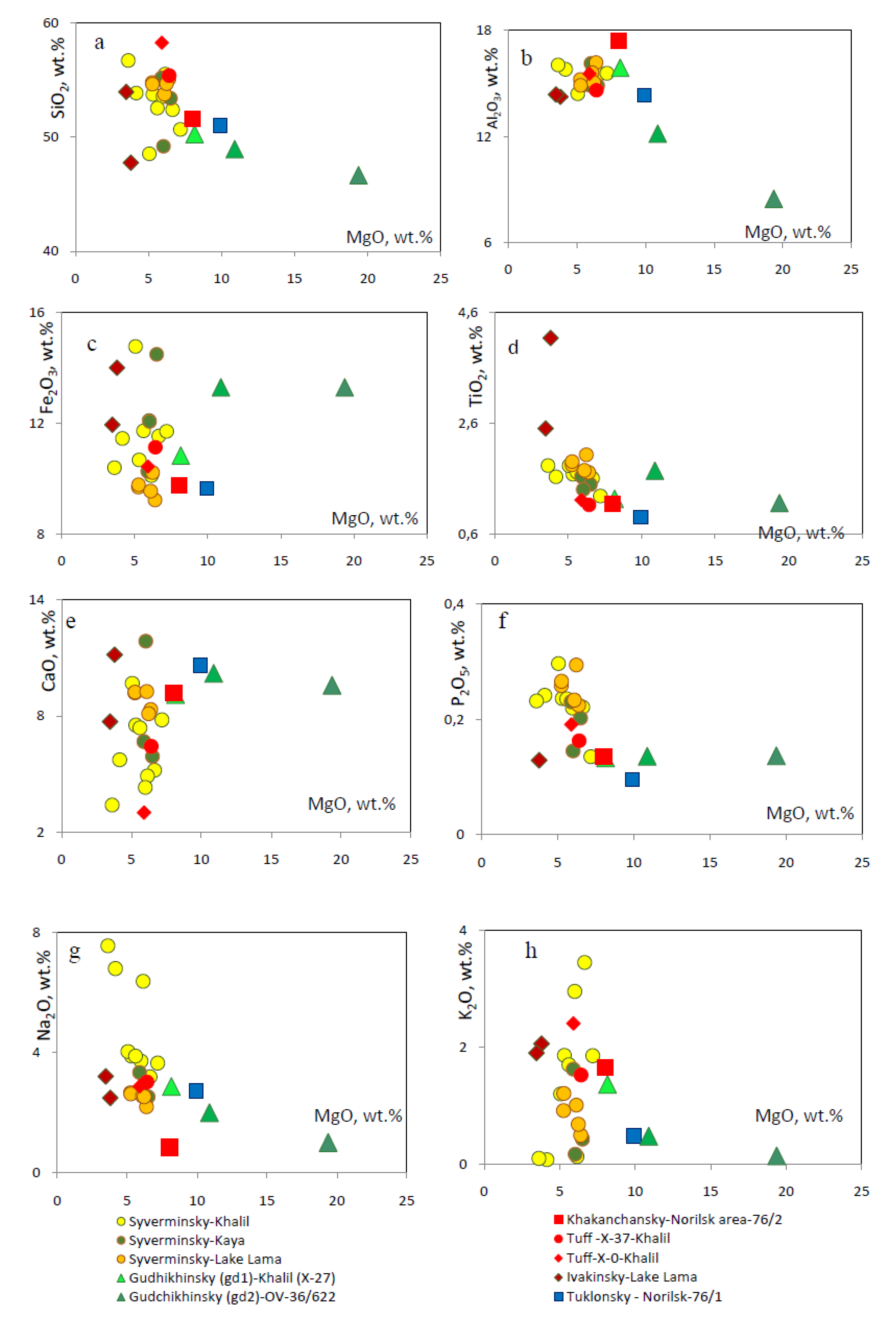
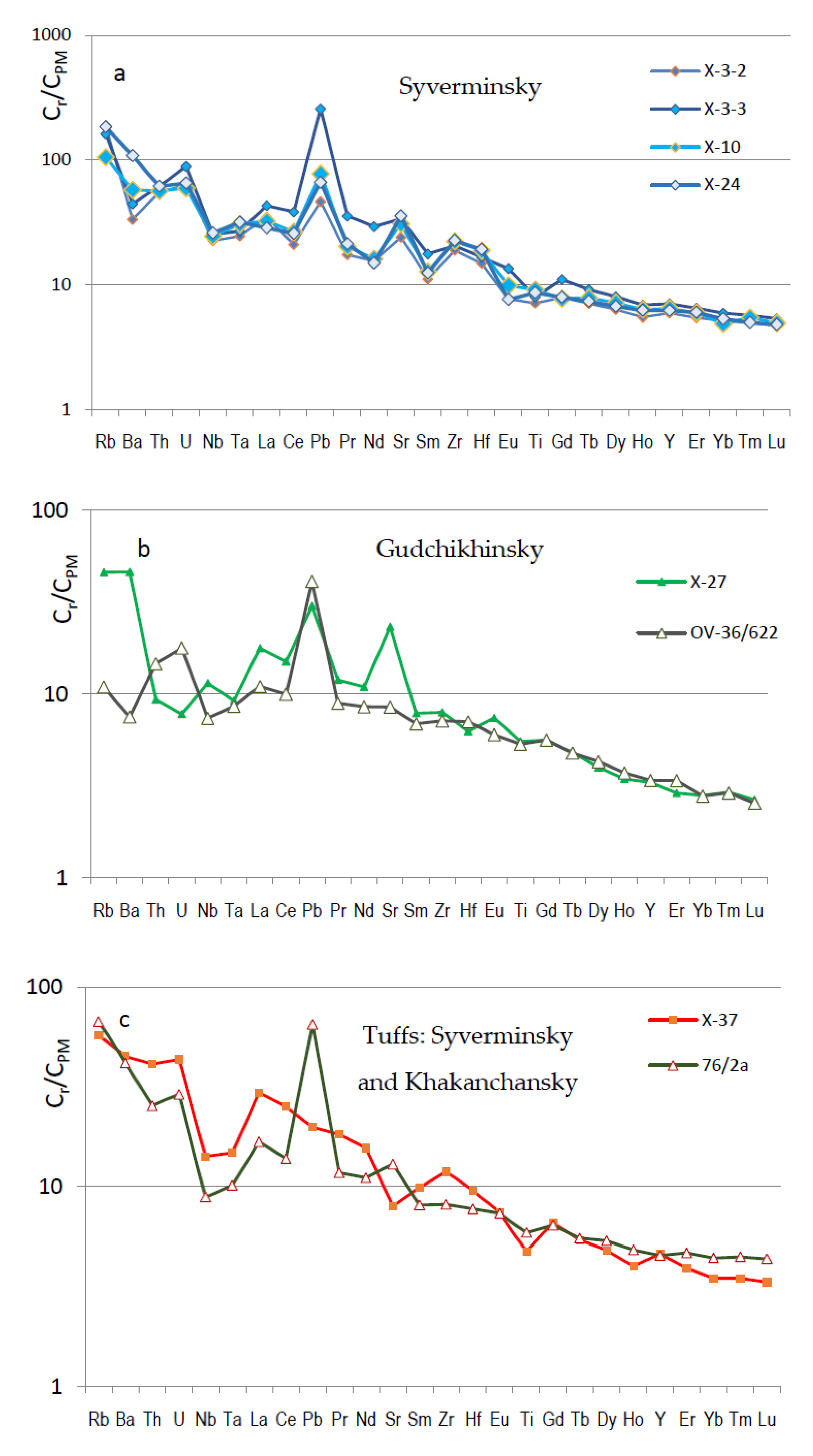
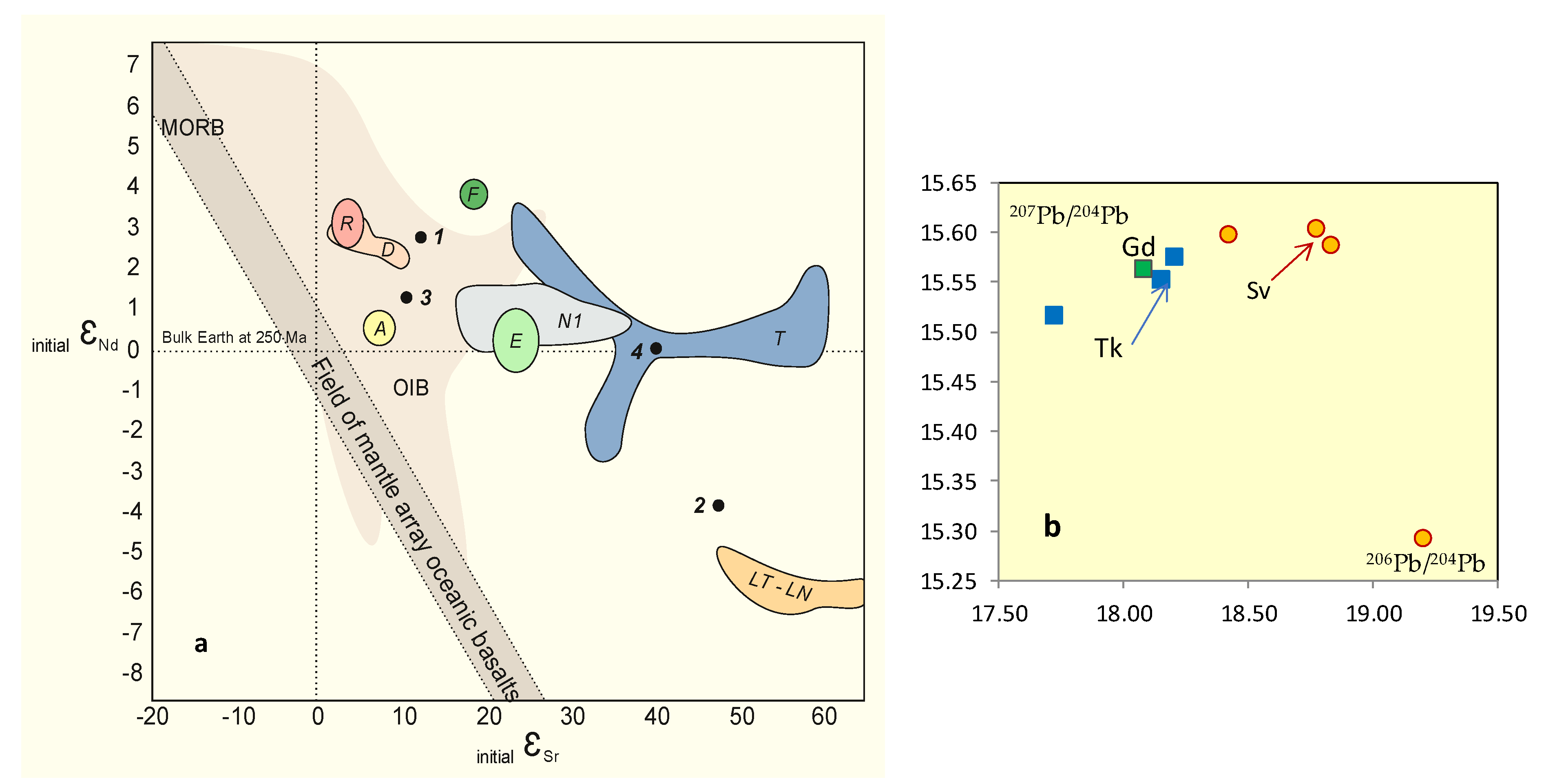
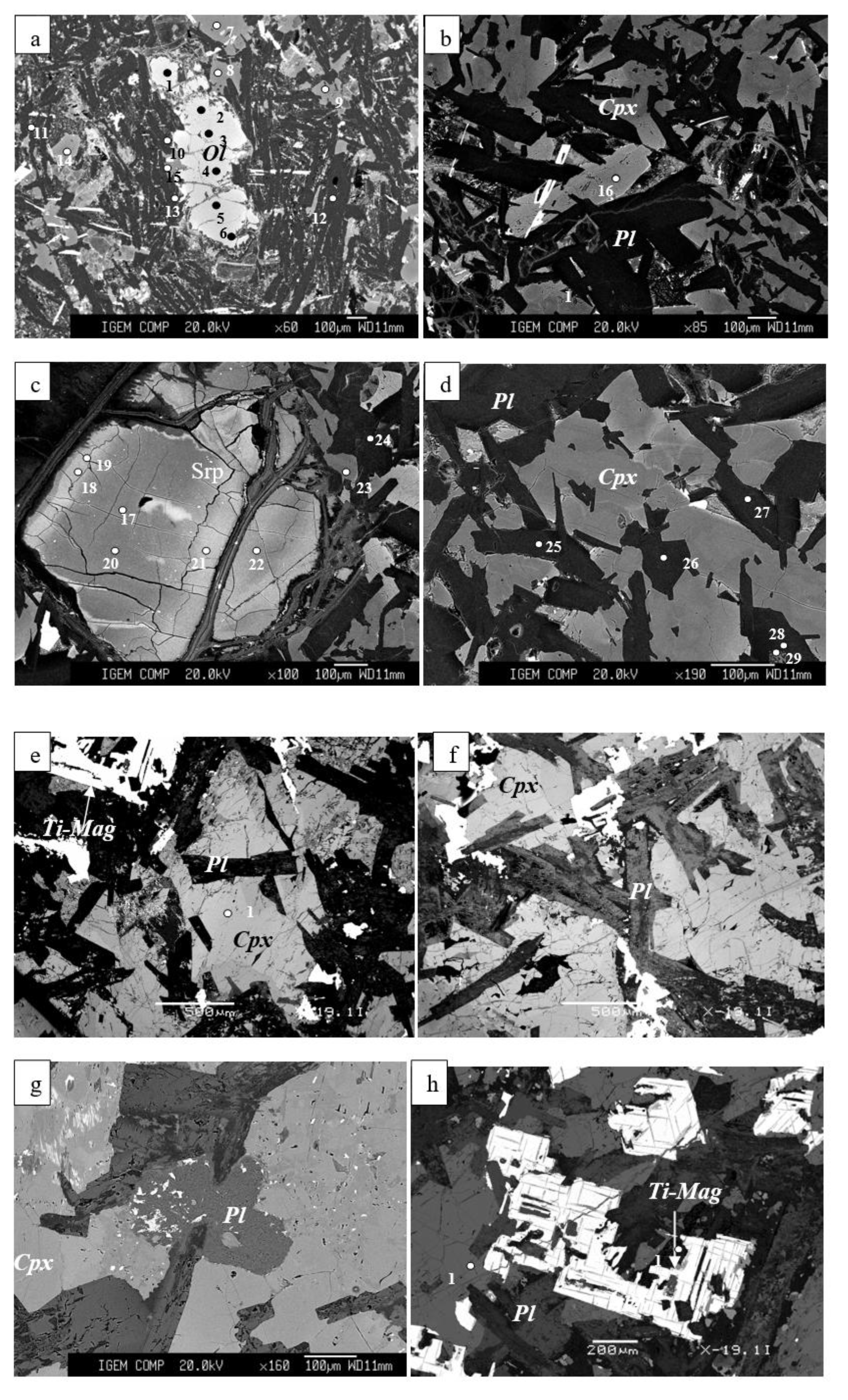

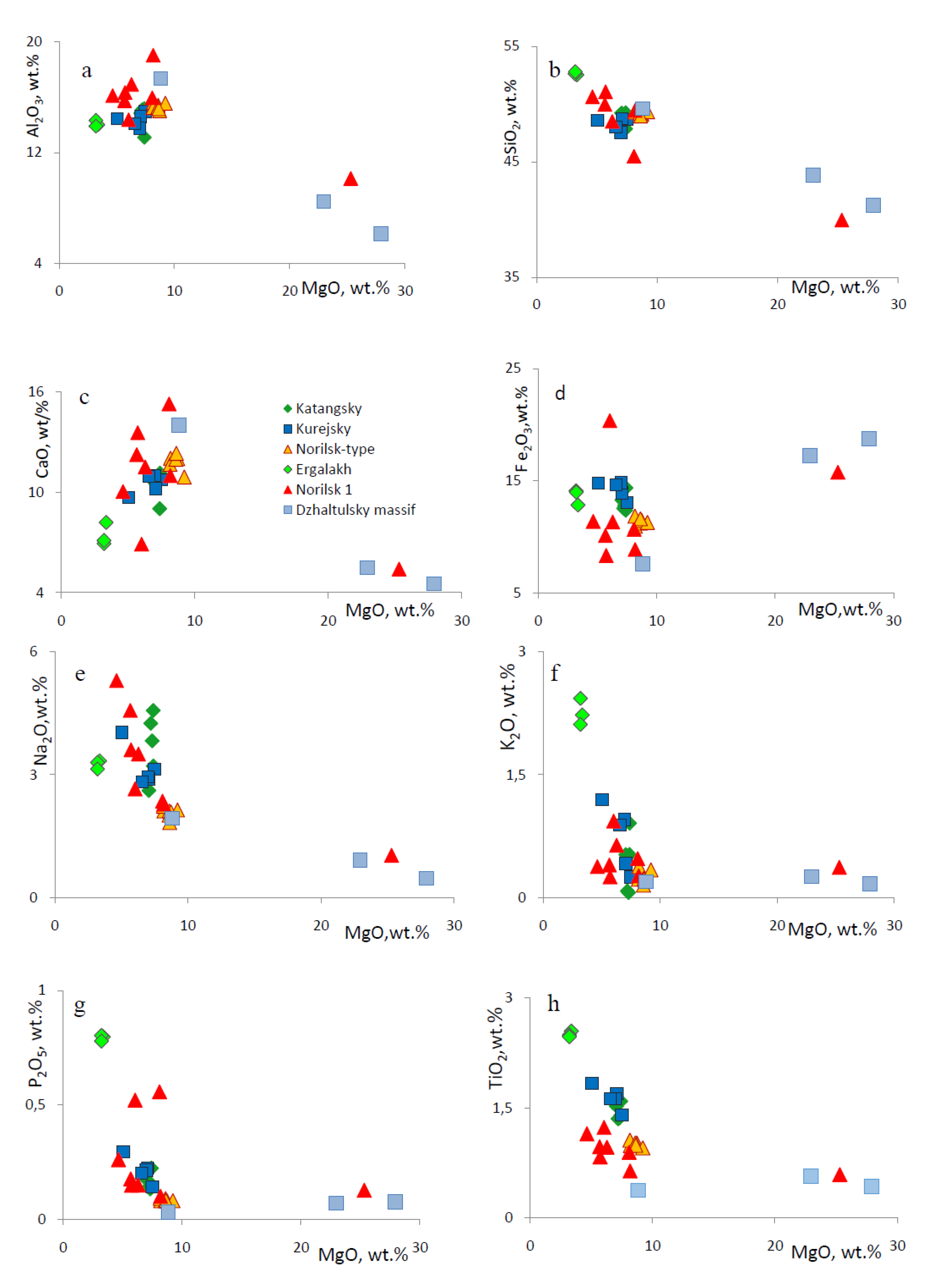

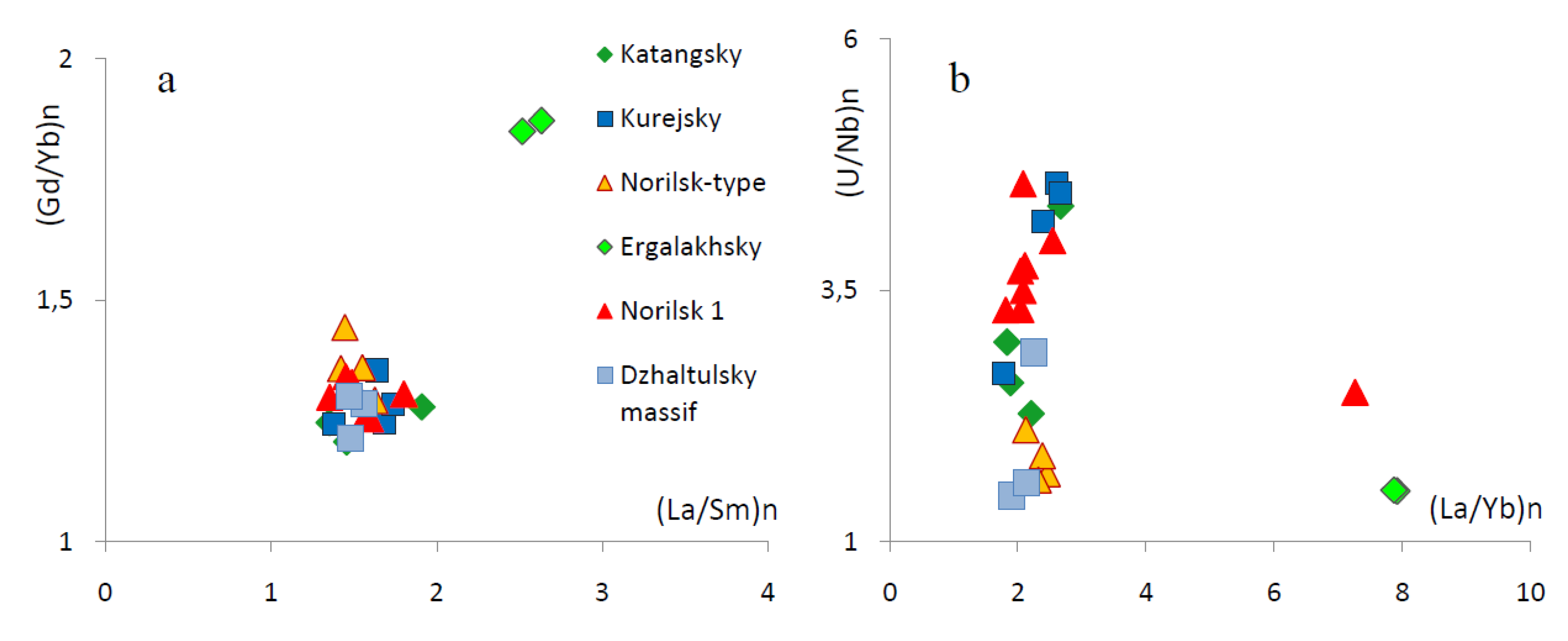
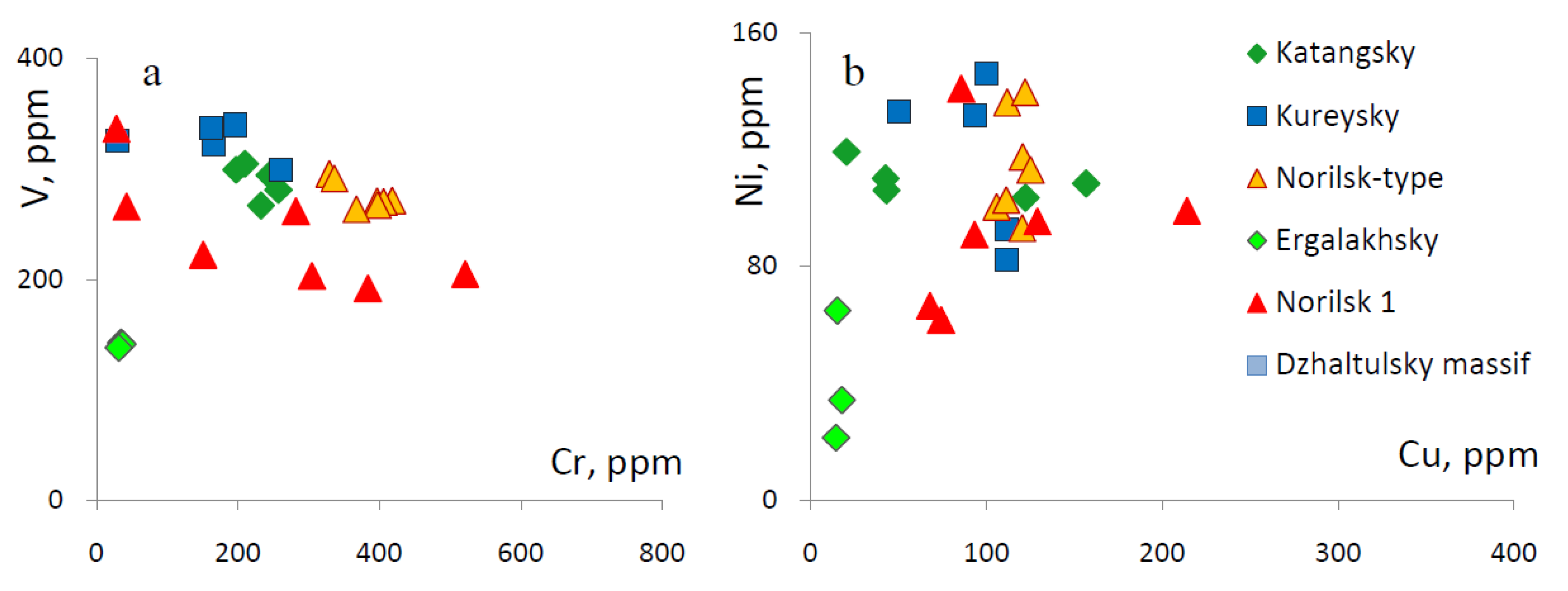
| No. | Sample | SiO2 | TiO2 | Al2O3 | FeO | MnO | MgO | CaO | Na2O | K2O | Total | Mineral |
|---|---|---|---|---|---|---|---|---|---|---|---|---|
| 1 | X-20 | 53.98 | bdl | 27.77 | 0.89 | bdl | 0.24 | 11.70 | 4.62 | 0.31 | 99.51 | Pl |
| 2 | X-20 | 55.62 | bdl | 26.84 | 0.95 | bdl | 0.10 | 10.57 | 5.32 | 0.41 | 99.80 | Pl |
| 3 | X-20 | 50.83 | bdl | 29.59 | 0.61 | bdl | 0.36 | 14.34 | 3.31 | 0.12 | 99.17 | Pl |
| 4 | X-20 | 51.74 | 0.40 | 3.63 | 6.63 | 0.14 | 16.16 | 20.21 | 0.23 | bdl | 99.36 | Cpx |
| 5 | X-20 | 51.43 | 0.52 | 1.62 | 12.68 | 0.31 | 14.48 | 18.04 | 0.22 | bdl | 99.35 | Cpx |
| 6 | X-20 | 49.30 | 0.20 | 6.04 | 18.15 | 0.32 | 14.25 | 8.98 | 0.38 | 0.09 | 97.71 | Glass |
| 7 | X-20 | 30.77 | 37.38 | 2.01 | 0.87 | 0.02 | 0.07 | 28.95 | 0.03 | 0.00 | 100.10 | Titanite |
| 8 | X-26 | 48.09 | 0.67 | 4.62 | 18.12 | 0.20 | 13.96 | 10.87 | 1.20 | 0.21 | 98.20 | Am |
| 9 | X-26 | 49.47 | 1.08 | 4.55 | 16.33 | 0.24 | 12.25 | 12.04 | 0.82 | 0.18 | 97.01 | Am |
| 10 | X-26 | 63.14 | 0.04 | 19.81 | 0.28 | 0.01 | 0.06 | 0.66 | 0.64 | 13.87 | 98.51 | Kps |
| 11 | X-26 | 58.31 | 0.07 | 25.61 | 0.78 | 0.02 | 0.07 | 8.06 | 6.23 | 0.52 | 99.66 | Pl |
| 12 | X-26 | 67.58 | 0.02 | 20.82 | 0.31 | 0.01 | 0.01 | 0.84 | 9.81 | 0.10 | 99.50 | Pl |
| 13 | X-26 | 57.06 | 0.15 | 27.17 | 0.94 | 0.02 | 0.23 | 7.33 | 4.82 | 1.87 | 99.59 | Pl |
| 14 | X-26 | 67.57 | 0.04 | 20.62 | 0.22 | 0.02 | 0.00 | 1.00 | 9.97 | 0.15 | 99.57 | Pl |
| 15 | X-26 | 54.06 | bdl | 27.48 | 1.07 | bdl | 0.36 | 11.41 | 4.78 | 0.27 | 99.42 | Pl |
| 16 | X-10 | 0.30 | 45.75 | 0.10 | 48.45 | 3.35 | 0.05 | 0.05 | 0.01 | 0.01 | 98.06 | Ilm |
| 17 | X-10 | 61.88 | 0.00 | 25.55 | 0.30 | 0.04 | 0.06 | 2.31 | 5.52 | 3.65 | 99.30 | Pl |
| 18 | X-10 | 48.26 | 0.04 | 26.79 | 2.31 | 0.08 | 0.43 | 13.69 | 1.51 | 3.66 | 96.76 | Pl |
| 19 | X-10 | 52.32 | 0.08 | 28.73 | 0.47 | 0.00 | 0.16 | 12.84 | 3.79 | 0.33 | 98.71 | Pl |
| 20 | X-10 | 50.71 | 0.39 | 3.41 | 17.14 | 0.25 | 12.14 | 12.37 | 0.34 | 0.17 | 97.69 | Px |
| 21 | X-10 | 39.05 | 0.79 | 11.52 | 22.21 | 0.18 | 14.54 | 0.71 | 0.03 | 4.83 | 93.86 | Am |
| 22 | X-10 | 54.07 | 0.05 | 28.16 | 0.56 | 0.03 | 0.15 | 11.87 | 4.18 | 0.36 | 99.42 | Am |
| 23 | X-10 | 51.93 | 0.32 | 2.75 | 20.29 | 0.42 | 10.69 | 12.77 | 0.34 | 0.12 | 99.61 | Cpx |
| 24 | X-37 | 62.46 | 2.18 | 18.62 | 0.20 | 0.00 | 0.03 | 2.57 | 8.63 | 0.32 | 95.01 | Glass |
| 25 | X-37 | 29.33 | 0.02 | 18.73 | 25.08 | 0.33 | 16.70 | 0.15 | 0.02 | 0.03 | 90.48 | Glass |
| 26 | X-37 | 28.19 | 0.01 | 17.66 | 25.41 | 0.32 | 16.25 | 0.11 | 0.01 | 0.02 | 88.10 | Glass |
| 27 | X-37 | 4.42 | 0.00 | 0.60 | 74.69 | 0.00 | 0.27 | 0.57 | 0.04 | 0.39 | 81.04 | Mag |
| 28 | X-37 | 64.01 | 0.03 | 19.54 | 0.10 | 0.00 | 0.01 | 0.03 | 0.34 | 15.22 | 99.28 | Kps |
| 29 | Х-27 | 50.30 | 1.08 | 2.00 | 10.09 | 0.24 | 14.99 | 19.41 | 0.31 | 0.00 | 98.41 | Cpx |
| 30 | Х-27 | 50.39 | 1.13 | 1.93 | 10.59 | 0.29 | 14.96 | 19.14 | 0.35 | 0.01 | 98.79 | Cpx |
| 31 | Х-27 | 51.33 | 0.69 | 1.97 | 7.70 | 0.20 | 15.94 | 21.49 | 0.25 | 0.02 | 99.58 | Cpx |
| 32 | Х-27 | 51.58 | 0.98 | 1.99 | 9.20 | 0.21 | 15.27 | 19.76 | 0.27 | 0.00 | 99.25 | Cpx |
| 33 | Х-27 | 50.82 | 0.15 | 2.81 | 23.40 | 0.65 | 15.63 | 2.93 | 0.54 | 0.12 | 97.04 | Opx |
| 34 | Х-27 | 51.22 | 0.08 | 30.36 | 0.70 | 0.02 | 0.10 | 13.67 | 2.90 | 0.92 | 99.96 | Pl |
| 35 | Х-27 | 53.96 | 0.14 | 29.43 | 0.72 | 0.00 | 0.09 | 10.34 | 4.99 | 0.42 | 100.07 | Pl |
| 36 | Х-27 | 0.29 | 47.42 | 0.05 | 48.12 | 1.93 | 0.06 | 0.08 | 0.00 | 0.01 | 97.95 | Ilm |
| 37 | Х-27 | 4.42 | 0.00 | 0.60 | 74.69 | 0.00 | 0.27 | 0.57 | 0.04 | 0.39 | 80.98 | Mag |
| 38 | Х-27 | 49.14 | 0.08 | 27.02 | 0.78 | 0.00 | 0.06 | 11.37 | 4.25 | 0.37 | 93.06 | Glass |
| 39 | Х-27 | 64.01 | 0.03 | 18.54 | 0.10 | 0.00 | 0.01 | 0.03 | 0.34 | 15.22 | 98.28 | Kps |
| 40 | Х-27 | 38.36 | bdl | bdl | 21.57 | 0.28 | 40.21 | 0.23 | bdl | bdl | 100.65 | Ol |
| 41 | Х-27 | 38.25 | bdl | bdl | 22.44 | 0.27 | 38.84 | 0.24 | bdl | bdl | 100.02 | Ol |
| 42 | Х-0 | 65.95 | 0.00 | 18.34 | 0.00 | 0.01 | 0.01 | 0.12 | 0.74 | 14.55 | 99.73 | Kps |
| No | 1 | 2 | 3 | 4 | 5 | 6 | 7 | 8 | |
|---|---|---|---|---|---|---|---|---|---|
| Sample, No | X-3-2 | X-3-3 | X-10 | X-20 | Х-21/3 | X-22 | X-24 | X-26 | |
| SiO2 | 51.26 | 53.84 | 51.34 | 49.74 | 53.23 | 52.31 | 47.46 | 48.64 | |
| TiO2 | 1.55 | 1.74 | 1.67 | 1.52 | 1.55 | 1.63 | 1.79 | 1.23 | |
| Al2O3 | 15.03 | 15.22 | 14.63 | 14.74 | 14.22 | 14.47 | 14.09 | 14.94 | |
| Fe2O3 | 10.89 | 9.86 | 11.45 | 10.94 | 9.68 | 10.38 | 14.44 | 11.23 | |
| MnO | 0.22 | 0.07 | 0.23 | 0.20 | 0.12 | 0.21 | 0.17 | 0.14 | |
| MgO | 3.95 | 3.43 | 5.47 | 6.30 | 5.88 | 5.16 | 4.94 | 6.89 | |
| CaO | 5.46 | 3.23 | 7.21 | 4.93 | 4.70 | 7.32 | 9.46 | 7.48 | |
| Na2O | 6.46 | 7.16 | 3.79 | 3.03 | 6.10 | 3.78 | 3.94 | 3.50 | |
| K2O | 0.07 | 0.09 | 1.66 | 3.28 | 0.12 | 1.81 | 1.17 | 1.78 | |
| P2O5 | 0.23 | 0.22 | 0.23 | 0.21 | 0.21 | 0.23 | 0.29 | 0.13 | |
| LOI | 4.65 | 4.98 | 2.23 | 4.74 | 3.92 | 2.41 | 3.63 | 3.89 | |
| Li | 22.77 | 17.51 | 22.71 | n/a | 29.91 | 35.7 | 86.54 | 34.44 | |
| Rb | 120 | 103 | 67.0 | n/a | 2.59 | 74.2 | 117 | 45.5 | |
| Sr | 508 | 712 | 652 | n/a | 253 | 659 | 754 | 1395 | |
| Y | 27.0 | 32.1 | 29.5 | n/a | 32.6 | 27.8 | 28.4 | 18.1 | |
| Cs | 0.64 | 0.09 | 2.02 | n/a | 0.06 | 0.96 | 0.29 | 0.45 | |
| Ba | 234 | 312 | 404 | n/a | 14 | 827 | 759 | 422 | |
| La | 24.0 | 29.6 | 22.3 | n/a | 67.8 | 21.2 | 19.7 | 21.1 | |
| Ce | 37.4 | 68.2 | 47.4 | n/a | 99.3 | 46.5 | 46.0 | 37.1 | |
| Pr | 4.81 | 9.82 | 5.62 | n/a | 8.80 | 5.10 | 5.90 | 4.47 | |
| Nd | 21.1 | 39.7 | 21.9 | n/a | 33.5 | 21.5 | 20.3 | 15.2 | |
| Sm | 4.94 | 7.85 | 5.68 | n/a | 6.65 | 5.06 | 5.54 | 3.68 | |
| Eu | 1.30 | 2.27 | 1.66 | n/a | 1.36 | 1.32 | 1.29 | 1.54 | |
| Gd | 4.71 | 6.59 | 4.64 | n/a | 6.09 | 4.97 | 4.76 | 3.41 | |
| Tb | 0.77 | 0.99 | 0.85 | n/a | 0.92 | 0.84 | 0.80 | 0.55 | |
| Dy | 4.67 | 5.93 | 5.30 | n/a | 5.51 | 5.15 | 4.97 | 3.50 | |
| Ho | 0.90 | 1.13 | 1.04 | n/a | 1.05 | 0.98 | 1.03 | 0.68 | |
| Er | 2.62 | 3.13 | 2.88 | n/a | 3.04 | 2.91 | 2.90 | 1.74 | |
| Tm | 0.37 | 0.42 | 0.40 | n/a | 0.42 | 0.39 | 0.37 | 0.24 | |
| Yb | 2.54 | 2.92 | 2.41 | n/a | 2.65 | 2.64 | 2.64 | 1.59 | |
| Lu | 0.35 | 0.40 | 0.37 | n/a | 0.38 | 0.39 | 0.36 | 0.23 | |
| Pb | 3.29 | 18.24 | 5.52 | n/a | 0.30 | 1.28 | 4.71 | 4.20 | |
| Th | 4.73 | 5.22 | 4.80 | n/a | 4.48 | 5.09 | 5.25 | 2.80 | |
| U | 1.32 | 1.87 | 1.25 | n/a | 1.23 | 1.46 | 1.38 | 0.71 | |
| Sc | 21.6 | 21.6 | 29.9 | n/a | 21.2 | 24.1 | 28.7 | 28.6 | |
| Ti | 9292 | 10431 | 11912 | n/a | 9292 | n/a | 11264 | 8358 | |
| V | 168 | 149 | 187 | n/a | 159 | 171 | 176 | 207 | |
| Cr | 183 | 188 | 219 | n/a | 204 | 206 | 219 | 305 | |
| Co | 25.3 | 7.6 | 33.9 | n/a | 24.9 | 26.3 | 18.4 | 53.9 | |
| Ni | 30.0 | 19.0 | 56.5 | n/a | 54.3 | 56.8 | 56.9 | 105.6 | |
| Cu | 28.3 | 26.5 | 125 | n/a | 17.4 | 9.21 | 17.5 | 113 | |
| Zn | 137 | 53.2 | 150 | n/a | 38.0 | 38.0 | 30.6 | 54.8 | |
| Ga | 20.0 | 23.1 | n/a | n/a | 18.5 | 18.4 | n/a | n/a | |
| Zr | 212 | 231 | 251 | n/a | 209 | 208 | 255 | 158 | |
| Nb | 16.1 | 18.2 | 17.6 | n/a | 15.8 | 19.2 | 18.6 | 8.8 | |
| Hf | 4.61 | 5.15 | 5.84 | n/a | 4.41 | 5.46 | 5.96 | 3.55 | |
| Ta | 1.01 | 1.10 | 1.26 | n/a | 1.03 | 1.16 | 1.31 | 0.53 | |
| No | 9 | 10 | 11 | 12 | 13 | 14 | 15 | 16 | 17 |
| Sample, No | X-27 | Х-28 | 3.20/1 | 3.21/1 | 3.23/1 | Х-37 | X-0 | 4270 | 4270/4 |
| SiO2 | 49.09 | 51.22 | 52.69 | 50.15 | 47.45 | 50.93 | 54.93 | 45.14 | 52.54 |
| TiO2 | 1.20 | 1.56 | 1.56 | 1.40 | 1.35 | 1.03 | 1.14 | 3.91 | 2.44 |
| Al2O3 | 15.50 | 14.67 | 14.22 | 13.96 | 15.55 | 13.43 | 14.64 | 13.46 | 13.99 |
| Fe2O3 | 10.57 | 11.56 | 9.79 | 13.60 | 11.63 | 10.23 | 9.83 | 13.23 | 11.62 |
| MnO | 0.18 | 0.12 | 0.23 | 0.17 | 0.24 | 0.13 | 0.13 | 0.21 | 0.19 |
| MgO | 7.96 | 5.72 | 5.62 | 6.10 | 5.80 | 5.89 | 5.56 | 3.58 | 3.37 |
| CaO | 8.88 | 4.12 | 6.37 | 5.55 | 11.43 | 5.91 | 2.84 | 10.54 | 7.50 |
| Na2O | 2.80 | 3.55 | 3.18 | 2.37 | 2.68 | 2.77 | 2.71 | 2.35 | 3.12 |
| K2O | 1.33 | 2.83 | 1.55 | 0.40 | 0.16 | 1.40 | 2.27 | 1.95 | 1.85 |
| P2O5 | 0.13 | 0.21 | 0.22 | 0.19 | 0.14 | 0.15 | 0.18 | 0.12 | 0.71 |
| LOI | 2.12 | 4.08 | 4.29 | 5.83 | 3.43 | 7.72 | 5.61 | 3.87 | 2.32 |
| Li | 19.77 | 34.13 | 13.54 | 17.20 | 21.25 | 41.89 | 36.60 | 20.31 | 8.61 |
| Be | 0.57 | 1.80 | 0.55 | 0.34 | 0.08 | 1.37 | n/a | 2.48 | 2.25 |
| Rb | 29 | 101 | 8.12 | 3.33 | 39 | 36 | 58 | 31 | 19 |
| Sr | 490 | 439 | 401 | 380 | 346 | 168 | 173 | 503 | 409 |
| Y | 15.1 | 26.6 | 20.2 | 26.1 | 26.0 | 21.0 | 24.9 | 46.9 | 35.9 |
| Cs | 1.14 | 0.25 | n/a | n/a | n/a | 0.28 | 0.32 | 0.78 | 1.90 |
| Ba | 323 | 337 | 230 | 292 | 585 | 315 | 989 | 986 | 848 |
| La | 12.2 | 20.7 | 21.2 | 22.3 | 35.2 | 20.4 | 26.5 | 43.2 | 26.9 |
| Ce | 26.7 | 46.5 | 42.2 | 48.9 | 68.4 | 44.6 | 56.2 | 101.6 | 69.1 |
| Pr | 3.3 | 5.42 | 4.59 | 6.03 | 7.53 | 5.05 | 6.76 | 13.02 | 9.29 |
| Nd | 14.8 | 23.9 | 17.3 | 25.2 | 28.9 | 21.2 | 22.2 | 52.6 | 40.0 |
| Sm | 3.49 | 5.64 | 4.19 | 6.13 | 6.38 | 4.41 | 5.27 | 10.51 | 8.81 |
| Eu | 1.25 | 1.36 | 1.58 | 1.82 | 1.71 | 1.25 | 1.39 | 2.80 | 2.66 |
| Gd | 3.35 | 5.27 | 3.91 | 5.71 | 5.93 | 3.94 | 4.23 | 9.59 | 8.17 |
| Tb | 0.52 | 0.80 | 0.64 | 0.90 | 0.88 | 0.59 | 0.80 | 1.50 | 1.34 |
| Dy | 2.94 | 4.79 | 3.89 | 5.05 | 5.02 | 3.55 | 4.52 | 8.82 | 7.93 |
| Ho | 0.57 | 0.90 | 0.77 | 1.00 | 0.99 | 0.66 | 0.90 | 1.80 | 1.60 |
| Er | 1.43 | 2.65 | 2.03 | 2.69 | 2.65 | 1.88 | 2.44 | 4.76 | 4.30 |
| Tm | 0.22 | 0.35 | 0.29 | 0.37 | 0.38 | 0.26 | 0.38 | 0.70 | 0.64 |
| Yb | 1.38 | 2.33 | 1.76 | 2.40 | 2.54 | 1.72 | 2.30 | 4.23 | 3.84 |
| Lu | 0.20 | 0.34 | 0.25 | 0.35 | 0.36 | 0.25 | 0.35 | 0.63 | 0.56 |
| Pb | 2.15 | 0.40 | 4.18 | 2.07 | 3.87 | 1.41 | 10.10 | 8.98 | 11.20 |
| Th | 0.79 | 4.11 | 5.22 | 2.90 | 4.12 | 3.50 | 5.53 | 3.42 | 1.43 |
| U | 0.2 | 1.01 | 1.41 | 0.76 | 1.07 | 0.91 | 1.35 | 2.07 | 1.37 |
| Sc | 26 | 22.1 | 12.1 | 24.0 | 21.7 | 21.8 | 32.4 | 18.9 | 14.2 |
| Ti | 7194 | 9352 | 5904 | 10316 | 8809 | 6175 | 8041 | 22308 | 6840 |
| V | 194 | 175 | 123 | 190 | 161 | 184 | 175 | 175 | 125 |
| Cr | 312 | 228 | 1736 | 158 | 212 | 272 | 226 | 49 | 160 |
| Co | 43.3 | 26.4 | 14.3 | 30.3 | 39.7 | 36.4 | 31.1 | 34.2 | 27.4 |
| Ni | 129 | 60.6 | 85.3 | 48.0 | 80.2 | 77.4 | 60.9 | 25.9 | 24.9 |
| Cu | 59.4 | 26.5 | 98.6 | 31.1 | 55.5 | 66.5 | 77.8 | 43.4 | 22.7 |
| Zn | 56 | 31.1 | bdl | bdl | 118.1 | 39.8 | 355 | 183 | 140 |
| Ga | 17.1 | 20.1 | n/a | n/a | n/a | 18.70 | n/a | 23.79 | 24.15 |
| Zr | 89.1 | 191 | 198 | 187 | 90 | 133 | 201 | 399 | 401 |
| Nb | 8.19 | 16.7 | 15.1 | 12.4 | 14.3 | 10.1 | 13.8 | 40.3 | 11.5 |
| Hf | 1.94 | 4.07 | 3.18 | 4.51 | 4.84 | 2.96 | 5.22 | 8.45 | 9.14 |
| Ta | 0.38 | 1.02 | 0.82 | 0.90 | 0.96 | 0.61 | 0.83 | 2.51 | 0.59 |
| No | 18 | 19 | 20 | 21 | 22 | 23 | 24 | 25 | 26 |
| Sample,No | 4270/5 | 4270/6 | 4270/8 | 4270/9 | 4270/12 | OV-36/622 | 75/2 | 76/2a | 76/1 |
| SiO2 | 52.76 | 52.99 | 53.02 | 51.84 | 52.60 | 46.31 | 46.75 | 46.23 | 48.08 |
| TiO2 | 1.64 | 1.78 | 1.85 | 1.68 | 1.95 | 1.14 | 1.66 | 1.02 | 0.85 |
| Al2O3 | 15.48 | 14.72 | 14.44 | 15.04 | 14.46 | 8.41 | 11.61 | 15.58 | 13.51 |
| Fe2O3 | 8.83 | 9.37 | 9.48 | 9.20 | 9.82 | 13.19 | 12.70 | 8.73 | 9.08 |
| MnO | 0.13 | 0.15 | 0.15 | 0.14 | 0.15 | 0.18 | 0.16 | 0.17 | 0.14 |
| MgO | 6.11 | 5.07 | 5.10 | 5.87 | 5.98 | 19.21 | 10.40 | 7.18 | 9.34 |
| CaO | 7.97 | 8.89 | 8.95 | 8.92 | 7.80 | 9.50 | 9.73 | 8.24 | 10.00 |
| Na2O | 2.10 | 2.57 | 2.54 | 2.46 | 2.43 | 1.00 | 1.91 | 0.76 | 2.56 |
| K2O | 0.47 | 0.88 | 1.17 | 0.97 | 0.65 | 0.14 | 0.45 | 1.48 | 0.45 |
| P2O5 | 0.22 | 0.25 | 0.26 | 0.23 | 0.28 | 0.14 | 0.13 | 0.12 | 0.09 |
| LOI | 3.91 | 2.88 | 2.98 | 3.15 | 3.42 | n/a | 4.11 | 10.28 | 4.90 |
| Li | 25.35 | 7.36 | 6.94 | 9.14 | 20.57 | n/a | n/a | n/a | n/a |
| Be | 1.72 | 1.63 | 1.74 | 1.61 | 1.31 | n/a | n/a | n/a | n/a |
| Rb | 19 | 41 | 41 | 41 | 24 | 6.94 | 7.01 | 43 | 9 |
| Sr | 510 | 374 | 367 | 407 | 548 | 179.34 | 147 | 275 | 210 |
| Y | 30.2 | 32.3 | 32.2 | 31.6 | 30.4 | 15.44 | 14.4 | 20.7 | 20.3 |
| Cs | 0.20 | 1.82 | 1.92 | 2.41 | 0.27 | n/a | n/a | n/a | n/a |
| Ba | 331 | 369 | 377 | 343 | 370 | 52.45 | 37.4 | 291 | 166 |
| La | 24.7 | 24.9 | 25.4 | 24.4 | 23.8 | 7.55 | 6.41 | 11.6 | 14.2 |
| Ce | 52.4 | 56.1 | 55.9 | 53.1 | 50.5 | 17.7 | 15.6 | 24.6 | 29.0 |
| Pr | 6.47 | 6.99 | 7.01 | 6.56 | 6.32 | 2.46 | 2.19 | 3.25 | 3.54 |
| Nd | 26.2 | 28.8 | 28.6 | 27.2 | 26.8 | 11.6 | 10.7 | 15.0 | 15.0 |
| Sm | 5.62 | 6.18 | 6.24 | 5.96 | 6.02 | 3.05 | 2.78 | 3.60 | 3.41 |
| Eu | 1.64 | 1.85 | 1.82 | 1.84 | 1.94 | 1.01 | 0.94 | 1.24 | 0.94 |
| Gd | 5.48 | 5.99 | 6.08 | 5.88 | 5.96 | 3.52 | 3.15 | 3.84 | 3.60 |
| Tb | 0.87 | 0.99 | 0.97 | 0.92 | 0.91 | 0.51 | 0.48 | 0.60 | 0.58 |
| Dy | 5.15 | 5.72 | 5.68 | 5.45 | 5.37 | 3.16 | 3.05 | 3.97 | 3.87 |
| Ho | 1.04 | 1.09 | 1.14 | 1.10 | 1.08 | 0.61 | 0.57 | 0.80 | 0.78 |
| Er | 2.75 | 3.02 | 3.02 | 2.95 | 2.80 | 1.62 | 1.46 | 2.25 | 2.24 |
| Tm | 0.40 | 0.50 | 0.44 | 0.43 | 0.40 | 0.21 | 0.21 | 0.33 | 0.33 |
| Yb | 2.43 | 2.77 | 2.72 | 2.58 | 2.41 | 1.38 | 1.31 | 2.18 | 2.17 |
| Lu | 0.35 | 0.38 | 0.38 | 0.37 | 0.35 | 0.19 | 0.19 | 0.32 | 0.32 |
| Pb | 7.36 | 7.32 | 7.30 | 6.34 | 6.30 | 2.90 | 2.31 | 4.62 | 5.34 |
| Th | 4.30 | 4.45 | 4.48 | 4.37 | 2.63 | 1.24 | 0.94 | 2.16 | 3.12 |
| U | 1.27 | 1.14 | 1.16 | 1.12 | 0.67 | 0.37 | 0.31 | 0.61 | 0.79 |
| Sc | 22.7 | 25.0 | 25.7 | 24.6 | 27.6 | 226 | n/a | 36.5 | 33.3 |
| Ti | 9427 | 10512 | 10509 | 10210 | 11635 | 6936 | 9762 | 7700 | 4892 |
| V | 174 | 179 | 189 | 186 | 217 | n/a | n/a | n/a | n/a |
| Cr | 322 | 325 | 322 | 395 | 208 | 91 | n/a | n/a | n/a |
| Co | 37.4 | 35.6 | 35.8 | 39.4 | 37.8 | 112 | 72 | 41.4 | 51.0 |
| Ni | 113 | 80.5 | 70.5 | 135 | 61.0 | 133 | 1324 | 117.5 | 346.4 |
| Cu | 65.1 | 39.8 | 38.5 | 32.7 | 34.3 | 132 | 118 | 98.8 | 70.1 |
| Zn | 92.5 | 97.0 | 97.7 | 96.1 | 103 | 79.9 | n/a | 86.0 | 87.7 |
| Ga | 20.08 | 20.42 | 20.40 | 20.78 | 19.52 | 5.26 | n/a | n/a | n/a |
| Zr | 206 | 220 | 221 | 215 | 206 | 79.9 | 81 | 91.4 | 87.5 |
| Nb | 29.6 | 18.0 | 18.0 | 16.0 | 16.6 | 5.25 | 5.71 | 6.3 | 5.7 |
| Hf | 4.99 | 5.41 | 5.35 | 5.20 | 4.90 | 2.18 | 2.22 | 2.40 | 2.38 |
| Ta | 1.01 | 1.06 | 1.06 | 1.02 | 0.85 | 0.35 | 0.38 | 0.42 | 0.39 |
| № | 1 | 2 | 3 | 4 | 5 | 6 | 7 | 8 |
|---|---|---|---|---|---|---|---|---|
| Sample, No | X-3-3 | X-3-2 | X-15-2 | X-28 | 76/2a | 76/б | 76/1 | 75/2 |
| Rock | basalt | basalt | basalt | basalt | tuff | basalt | tuff | picrite |
| Weight, g | 0.10672 | 0.11290 | 0.13360 | 0.10987 | 0.11450 | 0.18842 | 0.23990 | 0.13344 |
| Rb, ppm | 2.54 | 2.59 | 15.6 | 88.6 | 39.8 | 94.7 | 7.84 | 9.57 |
| Sr, ppm | 329 | 711 | 666 | 399 | 242 | 395 | 195 | 245 |
| 87Rb/86Sr | 0.02227 | 0.01053 | 0.06796 | 0.64244 | 0.47512 | 0.69330 | 0.11636 | 0.11312 |
| 87Sr/86Sr | 0.707445 | 0.707949 | 0.708479 | 0.709811 | 0.709010 | 0.708855 | 0.707744 | 0.705839 |
| ±2σ | 0.000005 | 0.000006 | 0.000006 | 0.000004 | 0.000004 | 0.000006 | 0.000005 | 0.000004 |
| Sri | 0.707366 | 0.707912 | 0.708237 | 0.707526 | 0.707313 | 0.706380 | 0.707329 | 0.705435 |
| ε Sr | 44.82 | 52.57 | 57.19 | 47.10 | 44.09 | 30.83 | 44.31 | 17.42 |
| Sm, ppm | 7, 40 | 5, 65 | 6, 48 | 5, 60 | 3, 138 | 3, 90 | 3, 13 | 3, 938 |
| Nd, ppm | 35, 3 | 26, 0 | 30, 3 | 23, 5 | 13, 07 | 19, 31 | 13, 39 | 14, 34 |
| 147Sm/144Nd | 0.12677 | 0.13129 | 0.12915 | 0.14379 | 0.14511 | 0.12203 | 0.14132 | 0.16597 |
| 143Nd/144Nd | 0.512362 | 0.512373 | 0.512388 | 0.512397 | 0.512426 | 0.512356 | 0.512318 | 0.512785 |
| ±2σ | 0.000003 | 0.000003 | 0.000006 | 0.000002 | 0.000004 | 0.000002 | 0.000002 | 0.000005 |
| Ndi | 0.512154 | 0.512157 | 0.512176 | 0.512161 | 0.512188 | 0.512156 | 0.512086 | 0512512 |
| εNd | −3.14 | −3.07 | −2.70 | −3.01 | −2.47 | −3.10 | −4.47 | 3.85 |
| 206Pb/204Pb | 19.0326 | 19.4625 | 23.5360 | 27.3000 | 18.4879 | 18.5422 | 18.2293 | 18.4164 |
| ±2σ | 0.0005 | 0.0008 | 0.0009 | 0.0029 | 0.0016 | 0.0007 | 0.0004 | 0.0006 |
| 207Pb/204Pb | 15.6165 | 15.6501 | 15.8283 | 15.7062 | 15.5697 | 15.5916 | 15.5421 | 15.5794 |
| ±2σ | 0.0005 | 0.0007 | 0.0007 | 0.0017 | 0.0013 | 0.0008 | 0.0004 | 0.0007 |
| 208Pb/204Pb | 38.7409 | 39.3205 | 40.7615 | 48.4215 | 38.4723 | 38.5210 | 38.2509 | 38.6319 |
| ±2σ | 0.0016 | 0.0022 | 0.0018 | 0.0052 | 0.0032 | 0.0029 | 0.0012 | 0.0025 |
| 206Pb/204Pb * | 18.7713 | 18.4227 | 18.8326 | 19.2021 | 18.1548 | 18.2085 | 17.7263 | 18.0827 |
| 207Pb/204Pb * | 15.6031 | 15.5969 | 15.5873 | 15.2914 | 15.5526 | 15.5745 | 15.5163 | 15.5623 |
| 208Pb/204Pb * | 38.5034 | 38.1128 | 37.9942 | 37.7191 | 38.0887 | 38.1367 | 37.7150 | 38.2471 |
| No | Sample, No | SiO2 | TiO2 | Al2O3 | FeO | MnO | MgO | CaO | Na2O | K2O | Cr2O3 | Total | Mineral |
|---|---|---|---|---|---|---|---|---|---|---|---|---|---|
| 1 | X-48 | 36.57 | 0.02 | 0.02 | 37.08 | 0.57 | 27.14 | 0.33 | 0.05 | bdl | bdl | 101.80 | Ol |
| 2 | X-48 | 36.30 | 0.04 | 0.01 | 38.19 | 0.68 | 26.22 | 0.34 | 0.00 | bdl | 0.01 | 101.82 | Ol |
| 3 | X-48 | 35.65 | 0.07 | 0.01 | 36.04 | 0.54 | 28.47 | 0.30 | 0.01 | bdl | 0.01 | 101.12 | Ol |
| 4 | X-48 | 35.67 | bdl | 0.02 | 36.05 | 0.53 | 28.48 | 0.32 | 0.02 | bdl | 0.03 | 101.15 | Ol |
| 5 | X-48 | 36.75 | 0.02 | 0.03 | 34.51 | 0.52 | 29.26 | 0.28 | 0.01 | bdl | 0.01 | 101.45 | Ol |
| 6 | X-48 | 36.61 | 0.03 | 0.03 | 36.60 | 0.57 | 27.48 | 0.32 | 0.03 | bdl | bdl | 101.67 | Ol |
| 7 | X-48 | 52.59 | 0.87 | 1.55 | 11.79 | 0.29 | 14.47 | 18.75 | 0.26 | bdl | 0.14 | 100.71 | Cpx |
| 8 | X-48 | 51.96 | 0.95 | 1.65 | 12.61 | 0.33 | 13.99 | 18.05 | 0.22 | 0.03 | 0.07 | 99.87 | Cpx |
| 9 | X-48 | 50.94 | 1.34 | 2.35 | 12.84 | 0.31 | 13.63 | 18.53 | 0.31 | 0.00 | 0.13 | 100.39 | Cpx |
| 10 | X-48 | 56.37 | 0.12 | 27.06 | 0.74 | 0.02 | 0.10 | 9.91 | 5.01 | 0.70 | bdl | 100.03 | Pl |
| 11 | X-48 | 57.78 | 0.14 | 26.06 | 0.71 | bdl | 0.07 | 8.79 | 5.40 | 1.00 | bdl | 99.94 | Pl |
| 12 | X-48 | 56.11 | 0.12 | 27.07 | 0.52 | bdl | 0.12 | 10.21 | 5.03 | 0.66 | bdl | 99.84 | Pl |
| 13 | X-48 | 55.49 | 0.11 | 27.56 | 0.66 | 0.01 | 0.11 | 10.48 | 4.85 | 0.60 | bdl | 99.87 | Pl |
| 14 | X-48 | 52.32 | 0.91 | 1.48 | 12.07 | 0.26 | 14.45 | 18.98 | 0.25 | bdl | 0.08 | 100.84 | Cpx |
| 15 | X-48 | 51.56 | 1.35 | 2.32 | 12.47 | 0.32 | 13.82 | 18.86 | 0.27 | 0.01 | 0.13 | 101.10 | Cpx |
| 16 | X-32 | 52.16 | 1.00 | 1.71 | 14.32 | 0.31 | 15.56 | 15.56 | 0.23 | 0.00 | 0.02 | 100.87 | Cpx |
| 17 | X-32 | 49.25 | bdl | 0.15 | 25.03 | 0.21 | 12.13 | 1.51 | 0.01 | 0.12 | 0.07 | 88.50 | Cpx |
| 18 | X-32 | 46.97 | bdl | 0.78 | 27.18 | 0.35 | 10.89 | 1.34 | 0.03 | 0.13 | 0.04 | 87.77 | Sp |
| 19 | X-32 | 44.09 | bdl | 0.30 | 31.56 | 0.47 | 8.39 | 1.80 | 0.02 | 0.09 | 0.07 | 86.82 | Sp |
| 20 | X-32 | 49.27 | bdl | 0.13 | 26.02 | 0.30 | 11.82 | 1.81 | 0.02 | 0.13 | 0.09 | 89.66 | Sp |
| 21 | X-32 | 44.43 | bdl | 0.43 | 32.60 | 0.54 | 8.46 | 1.76 | 0.02 | 0.07 | 0.07 | 88.40 | Sp |
| 22 | X-32 | 44.51 | bdl | 2.35 | 29.87 | 0.45 | 9.52 | 1.81 | 0.00 | 0.09 | 0.07 | 88.69 | Sp |
| 23 | X-32 | 52.02 | 0.72 | 3.42 | 8.25 | 0.17 | 15.53 | 19.65 | 0.23 | bdl | 0.31 | 100.31 | Cpx |
| 24 | X-32 | 48.75 | 0.05 | 27.66 | 3.97 | 0.09 | 1.26 | 13.17 | 2.35 | 0.11 | bdl | 97.41 | Pl |
| 25 | X-32 | 50.61 | 0.03 | 30.80 | 0.97 | 0.01 | 0.10 | 14.60 | 3.00 | 0.15 | 0.02 | 100.28 | Pl |
| 26 | X-32 | 52.02 | 0.05 | 29.85 | 0.83 | 0.04 | 0.12 | 13.68 | 3.32 | 0.16 | 0.06 | 100.12 | Pl |
| 27 | X-32 | 50.81 | 0.01 | 30.48 | 0.80 | 0.03 | 0.12 | 14.28 | 2.71 | 0.15 | 0.03 | 99.41 | Pl |
| 28 | X-32 | 49.28 | 0.01 | 32.29 | 0.82 | 0.03 | 0.08 | 15.93 | 2.23 | 0.09 | bdl | 100.75 | Pl |
| 29 | X-32 | 55.81 | 0.11 | 27.27 | 0.88 | 0.00 | 0.07 | 10.52 | 4.96 | 0.31 | 0.02 | 99.96 | Pl |
| 30 | X-35 | 0.26 | 41.90 | 0.13 | 51.61 | 3.86 | 0.09 | 0.01 | 0.06 | bdl | 0.04 | 97.95 | Ilm |
| 31 | X-35 | 0.38 | 9.07 | 4.04 | 77.60 | 1.53 | 2.55 | 0.02 | 0.00 | bdl | 0.02 | 95.26 | Mag |
| 32 | X-35 | 53.19 | 0.09 | 29.22 | 1.17 | 0.02 | 0.08 | 12.37 | 4.07 | 0.26 | 0.01 | 100.50 | Pl |
| 33 | X-35 | 50.94 | 0.68 | 3.69 | 8.07 | 0.18 | 14.79 | 21.28 | 0.31 | bdl | 0.09 | 100.04 | Cpx |
| 34 | X-35 | 51.71 | 0.57 | 3.05 | 7.44 | 0.20 | 15.47 | 21.26 | 0.28 | bdl | 0.10 | 100.12 | Cpx |
| 35 | X-35 | 53.72 | 0.55 | 1.61 | 7.83 | 0.50 | 15.45 | 20.08 | 0.55 | 0.04 | bdl | 100.33 | Cpx |
| 36 | X-35 | 51.18 | 0.88 | 3.77 | 9.61 | 0.21 | 14.38 | 21.02 | 0.38 | bdl | 0.01 | 101.46 | Cpx |
| 37 | X-35 | 51.57 | 0.03 | 30.35 | 1.03 | 0.02 | 0.08 | 13.93 | 3.32 | 0.17 | 0.01 | 100.50 | Pl |
| 38 | X-35 | 54.89 | 0.05 | 27.95 | 0.88 | bdl | 0.09 | 11.09 | 4.78 | 0.32 | bdl | 100.05 | Pl |
| 39 | X-35 | 59.18 | 0.04 | 23.67 | 1.90 | 0.03 | 1.07 | 5.75 | 6.62 | 0.31 | bdl | 98.57 | Pl |
| 40 | X-35 | 53.19 | 0.11 | 29.35 | 1.57 | 0.04 | 0.04 | 12.75 | 3.96 | 0.20 | bdl | 101.22 | Pl |
| 41 | X-7 | 51.42 | 0.61 | 2.97 | 7.50 | 0.18 | 15.01 | 21.35 | 0.30 | bdl | 0.15 | 99.47 | Cpx |
| 42 | X-7 | 53.06 | 0.03 | 0.31 | 6.36 | 0.32 | 15.56 | 23.55 | 0.15 | bdl | 0.03 | 99.37 | Cpx |
| 43 | X-7 | 49.22 | 1.13 | 3.66 | 10.16 | 0.28 | 14.27 | 20.01 | 0.40 | bdl | bdl | 99.12 | Cpx |
| 44 | X-7 | 50.09 | 0.85 | 2.77 | 9.85 | 0.29 | 14.79 | 19.97 | 0.39 | 0.01 | 0.01 | 98.99 | Cpx |
| 45 | X-7 | 50.77 | 0.50 | 3.11 | 7.09 | 0.18 | 15.79 | 21.45 | 0.28 | bdl | 0.35 | 99.53 | Cpx |
| 46 | X-7 | 54.94 | 0.09 | 28.01 | 0.86 | 0.01 | 0.08 | 10.52 | 4.88 | 0.35 | bdl | 99.74 | Pl |
| 47 | X-10 | 54.77 | 0.08 | 27.73 | 0.92 | bdl | 0.12 | 10.76 | 4.63 | 0.33 | bdl | 99.33 | Pl |
| 48 | X-10 | 54.41 | 0.10 | 27.38 | 0.92 | bdl | 0.12 | 11.67 | 4.30 | 0.26 | 0.02 | 99.19 | Pl |
| 49 | X-10 | 42.59 | 0.20 | 12.71 | 11.38 | 0.13 | 14.29 | 11.20 | 3.28 | 0.50 | 0.02 | 96.29 | Am |
| 50 | X-19 | 67.91 | bdl | 20.54 | 0.26 | bdl | 0.01 | 1.08 | 9.98 | 0.03 | bdl | 99.82 | Pl |
| 51 | X-19 | 52.50 | 0.48 | 2.63 | 9.07 | 0.36 | 18.18 | 11.89 | 1.05 | 0.28 | bdl | 96.44 | Am |
| 52 | X-19 | 29.41 | 34.51 | 0.77 | 2.08 | 0.07 | 0.02 | 27.02 | 0.00 | bdl | 0.01 | 93.90 | Titanite |
| 53 | X-19 | 49.02 | 1.16 | 4.4 | 10.01 | 0.22 | 13.98 | 20.33 | 0.41 | bdl | bdl | 99.53 | Cpx |
| 54 | X-19 | 51.05 | 0.66 | 2.76 | 9.86 | 0.25 | 15.05 | 19.77 | 0.33 | bdl | bdl | 99.73 | Cpx |
| 55 | X-19 | 48.9 | 1.13 | 4.44 | 10.31 | 0.26 | 13.85 | 20.14 | 0.41 | bdl | bdl | 99.44 | Cpx |
| 56 | X-19 | 50.9 | 0.71 | 2.73 | 9.87 | 0.29 | 15.05 | 19.42 | 0.38 | bdl | bdl | 99.35 | Cpx |
| 57 | X-39 | 50.27 | 0.88 | 3.52 | 8.62 | 0.18 | 14.72 | 20.81 | 0.20 | bdl | 0.15 | 99.36 | Cpx |
| 58 | X-39 | 50.93 | 0.83 | 3.69 | 8.28 | 0.16 | 15.35 | 19.56 | 0.22 | bdl | 0.35 | 99.36 | Cpx |
| 59 | X-39 | 50.84 | 0.56 | 3.29 | 8.94 | 0.20 | 16.04 | 19.07 | 0.21 | bdl | 0.23 | 99.39 | Cpx |
| 60 | X-39 | 50.70 | 0.84 | 3.17 | 11.56 | 0.25 | 14.09 | 18.84 | 0.24 | bdl | 0.06 | 99.75 | Cpx |
| 61 | X-39 | 50.06 | 0.94 | 3.43 | 11.83 | 0.25 | 14.98 | 17.57 | 0.25 | 0.01 | 0.09 | 99.40 | Cpx |
| 62 | X-39 | 49.51 | 0.04 | 31.36 | 0.54 | bdl | 0.26 | 15.33 | 2.61 | 0.09 | bdl | 99.75 | Pl |
| 63 | X-39 | 52.27 | 0.03 | 29.66 | 0.99 | bdl | 0.41 | 12.24 | 3.84 | 0.17 | bdl | 99.61 | Pl |
| 64 | X-39 | 49.48 | bdl | 30.17 | 1.26 | 0.02 | 0.85 | 14.57 | 2.55 | 0.11 | bdl | 99.00 | Pl |
| 65 | X-39 | 50.71 | 0.04 | 30.34 | 0.70 | bdl | 0.29 | 14.89 | 2.79 | 0.10 | 0.01 | 99.86 | Pl |
| 66 | X-39 | 50.61 | 0.03 | 31.34 | 0.67 | 0.01 | 0.24 | 14.00 | 2.98 | 0.12 | bdl | 99.99 | Pl |
| 67 | X-39 | 49.34 | 0.09 | 4.97 | 17.84 | 0.47 | 12.26 | 10.85 | 0.96 | 0.05 | 0.01 | 96.84 | Am |
| No | 1 | 2 | 3 | 4 | 5 | 6 | 7 | 8 | 9 | 10 | |
|---|---|---|---|---|---|---|---|---|---|---|---|
| Sample, No | X-6 | X-6/1 | X-6-5 | X-7 | X-8 | X-8-3 | Х-18-1 | X-19 | X-25 | Х-35 | |
| SiO2 | 46.96 | 46.81 | 48.76 | 46.93 | 47.75 | 47.93 | 47.76 | 47.46 | 46.33 | 47.27 | |
| TiO2 | 1.31 | 1.32 | 1.51 | 1.56 | 1.35 | 1.38 | 1.66 | 1.79 | 1.58 | 1.6 | |
| Al2O3 | 14.65 | 14.44 | 14.68 | 12.83 | 14.69 | 14.72 | 14.3 | 14.09 | 13.39 | 13.83 | |
| Fe2O3 | 12.17 | 12.36 | 13.15 | 14.07 | 11.99 | 12.87 | 13.64 | 14.44 | 14.43 | 14.4 | |
| MnO | 0.157 | 0.168 | 0.196 | 0.215 | 0.199 | 0.174 | 0.21 | 0.165 | 0.224 | 0.208 | |
| MgO | 6.99 | 7.06 | 6.99 | 7.25 | 7.16 | 7.37 | 6.94 | 4.94 | 6.81 | 6.48 | |
| CaO | 10.52 | 10.62 | 10.44 | 10.93 | 8.75 | 10.58 | 10.03 | 9.46 | 10.71 | 10.79 | |
| Na2O | 4.13 | 3.7 | 2.59 | 3.15 | 4.43 | 3.09 | 2.84 | 3.94 | 2.87 | 2.78 | |
| K2O | 0.08 | 0.06 | 0.52 | 0.89 | 0.51 | 0.25 | 0.41 | 1.17 | 0.93 | 0.87 | |
| P2O5 | 0.14 | 0.13 | 0.17 | 0.22 | 0.14 | 0.14 | 0.22 | 0.29 | 0.21 | 0.2 | |
| LOI | 2.77 | 3.07 | 0.78 | 1.86 | 2.9 | 1.38 | 1.86 | 2.11 | 2.24 | 1.35 | |
| Rb | 1.44 | 0.76 | 13.5 | 19.5 | 15.9 | 6.7 | 9.4 | 22.1 | 25.5 | 21.2 | |
| Sr | 197 | 193 | 192 | 548 | 867 | 203 | 255 | 591 | 687 | 412 | |
| Y | 25.1 | 25.2 | 30.1 | 30.6 | 25.1 | 26.4 | 32.3 | 39.2 | 29.6 | 32.9 | |
| Ba | 67 | 62 | 162 | 199 | 96 | 85 | 157 | 227 | 219 | 211 | |
| La | 6.48 | 6.91 | 8.97 | 11.48 | 6.73 | 6.34 | 11.13 | 14.08 | 9.19 | 11.67 | |
| Ce | 15.7 | 16.4 | 21.9 | 25.2 | 16.2 | 15.7 | 26.4 | 31.9 | 23.5 | 27.2 | |
| Pr | 2.18 | 2.31 | 2.92 | 3.36 | 2.34 | 2.30 | 3.47 | 4.28 | 3.01 | 3.43 | |
| Nd | 10.1 | 10.8 | 14.0 | 14.2 | 10.5 | 9.69 | 16.6 | 19.2 | 14.3 | 16.2 | |
| Sm | 3.10 | 3.24 | 3.89 | 3.88 | 2.99 | 2.98 | 4.38 | 5.41 | 4.02 | 4.35 | |
| Eu | 1.05 | 1.13 | 1.30 | 1.38 | 1.00 | 1.06 | 1.39 | 1.70 | 1.25 | 1.38 | |
| Gd | 3.71 | 3.97 | 4.59 | 4.77 | 3.83 | 3.85 | 5.47 | 5.83 | 4.87 | 4.88 | |
| Tb | 0.68 | 0.71 | 0.76 | 0.76 | 0.65 | 0.66 | 0.88 | 0.99 | 0.82 | 0.83 | |
| Dy | 4.19 | 4.60 | 5.02 | 5.08 | 3.98 | 4.55 | 5.93 | 6.56 | 5.30 | 5.30 | |
| Ho | 0.93 | 0.96 | 1.03 | 1.15 | 1.01 | 0.93 | 1.20 | 1.37 | 1.10 | 1.07 | |
| Er | 2.62 | 2.75 | 2.98 | 2.83 | 2.52 | 2.63 | 3.67 | 4.02 | 3.34 | 3.31 | |
| Tm | 0.37 | 0.38 | 0.41 | 0.46 | 0.36 | 0.40 | 0.50 | 0.60 | 0.45 | 0.47 | |
| Yb | 2.46 | 2.70 | 2.91 | 3.08 | 2.63 | 2.56 | 3.34 | 3.87 | 3.01 | 3.14 | |
| Lu | 0.37 | 0.39 | 0.42 | 0.46 | 0.39 | 0.36 | 0.51 | 0.59 | 0.45 | 0.46 | |
| Pb | 0.99 | 0.71 | 3.04 | 1.05 | 1.03 | 1.51 | 2.22 | 1.58 | 0.99 | 1.54 | |
| Th | 0.97 | 0.89 | 1.22 | 1.69 | 0.97 | 1.07 | 1.84 | 2.36 | 1.43 | 1.68 | |
| U | 0.29 | 0.33 | 0.40 | 0.85 | 0.38 | 0.34 | 0.85 | 1.19 | 0.78 | 0.87 | |
| Sc | 31.1 | 38.9 | 39.5 | 32.6 | 29.8 | 32.3 | 37.8 | 28.3 | 39.3 | 35.6 | |
| V | 281 | 266 | 299 | 304 | 294 | 299 | 322 | 325 | 340 | 336 | |
| Cr | 257 | 233 | 197 | 210 | 245 | 260 | 165 | 29 | 197 | 163 | |
| Co | 42.8 | 51.9 | 47.5 | 48.8 | 36.8 | 44.1 | 45.7 | 48.8 | 50.1 | 46.3 | |
| Ni | 110 | 119 | 108 | 103 | 106 | 112 | 101 | 50 | 112 | 93.4 | |
| Cu | 42.9 | 20.8 | 157 | 123 | 43.3 | 92.8 | 146 | 133 | 82.1 | 132 | |
| Zn | 63.6 | 74.1 | 116.3 | 71.7 | 63.0 | 71.4 | 115.0 | 54.0 | 87.1 | 94.6 | |
| Zr | 78.8 | 87.5 | 106 | 108 | 95.7 | 85.5 | 131 | 181 | 108 | 130 | |
| Nb | 3.76 | 3.96 | 5.92 | 6.67 | 4.30 | 4.33 | 6.88 | 8.83 | 6.35 | 6.61 | |
| Hf | 2.56 | 2.40 | 2.60 | 2.92 | 2.74 | 2.32 | 3.45 | 4.64 | 2.83 | 3.05 | |
| Ta | 0.24 | 0.26 | 0.34 | 0.42 | 0.27 | 0.27 | 0.42 | 0.61 | 0.38 | 0.42 | |
| No | 11 | 12 | 13 | 14 | 15 | 16 | 17 | 18 | 19 | 20 | 21 |
| Sample, No | Х-29 | Х-31 | Х-32 | Х-33 | Х-34 | Х-43 | X-44 | X-46 | X-48 | X-40 | DM-27/20 |
| SiO2 | 48.17 | 48.06 | 48.14 | 47.94 | 47.89 | 47.65 | 47.12 | 50.68 | 51.06 | 51.46 | 47.20 |
| TiO2 | 0.96 | 0.96 | 1 | 1.03 | 0.99 | 0.92 | 0.95 | 2.46 | 2.42 | 2.41 | 0.94 |
| Al2O3 | 15.19 | 15.07 | 14.71 | 14.8 | 14.87 | 15.02 | 14.58 | 13.51 | 13.88 | 13.55 | 16.46 |
| Fe2O3 | 10.64 | 10.95 | 11.25 | 11.5 | 11.14 | 10.89 | 11.17 | 12.38 | 13.68 | 13.62 | 11.02 |
| MnO | 0.157 | 0.166 | 0.172 | 0.16 | 0.168 | 0.147 | 0.178 | 0.161 | 0.135 | 0.186 | 0.15 |
| MgO | 7.97 | 8.4 | 8.55 | 7.92 | 8.35 | 8.9 | 8.3 | 3.24 | 3.1 | 3.12 | 6.11 |
| CaO | 11.72 | 11.73 | 11.78 | 11.35 | 11.66 | 10.54 | 11.86 | 7.92 | 6.73 | 6.94 | 11.21 |
| Na2O | 2.06 | 2.07 | 2.05 | 2.17 | 1.96 | 2.07 | 1.76 | 3.22 | 3.2 | 3.06 | 3.41 |
| K2O | 0.37 | 0.23 | 0.21 | 0.22 | 0.15 | 0.33 | 0.22 | 2.15 | 2.05 | 2.37 | 0.62 |
| P2O5 | 0.08 | 0.09 | 0.08 | 0.09 | 0.08 | 0.08 | 0.08 | 0.77 | 0.78 | 0.76 | 0.15 |
| LOI | 2.55 | 2.13 | 1.86 | 2.66 | 2.59 | 3.25 | 3.57 | 3.16 | 2.82 | 2.12 | 2.29 |
| Rb | 13.7 | 6.1 | 9.0 | 8.0 | 5.1 | 8.7 | 6.6 | 49.7 | 49.0 | 56.6 | 19.8 |
| Sr | 261 | 226 | 233 | 236 | 235 | 205 | 212 | 383 | 404 | 437 | 369 |
| Y | 17.3 | 17.5 | 18.9 | 20.9 | 18.3 | 18.2 | 19.2 | 50.5 | 50.7 | 49.7 | 20.8 |
| Ba | 131 | 90 | 82 | 105 | 73 | 109 | 90 | 869 | 756 | 833 | 143 |
| La | 4.61 | 4.86 | 5.98 | 6.12 | 5.30 | 5.03 | 6.28 | 51.69 | 45.42 | 44.66 | 6.32 |
| Ce | 11.0 | 11.3 | 12.6 | 14.2 | 12.5 | 12.1 | 14.7 | 111.8 | 98.3 | 96.1 | 15.1 |
| Pr | 1.43 | 1.56 | 1.65 | 1.87 | 1.67 | 1.60 | 1.92 | 13.57 | 12.24 | 11.98 | 2.00 |
| Nd | 6.73 | 7.02 | 8.09 | 8.99 | 8.34 | 7.88 | 8.72 | 55.0 | 47.2 | 46.4 | 9.8 |
| Sm | 2.09 | 2.31 | 2.38 | 2.55 | 2.37 | 2.29 | 2.57 | 12.00 | 11.16 | 11.47 | 2.68 |
| Eu | 0.76 | 0.85 | 0.87 | 0.96 | 0.91 | 0.84 | 0.98 | 3.51 | 3.12 | 3.10 | 0.99 |
| Gd | 2.48 | 2.70 | 2.73 | 3.03 | 2.86 | 2.79 | 3.03 | 11.10 | 9.31 | 9.09 | 3.43 |
| Tb | 0.45 | 0.40 | 0.48 | 0.50 | 0.47 | 0.45 | 0.53 | 1.73 | 1.54 | 1.49 | 0.58 |
| Dy | 2.98 | 3.03 | 3.03 | 3.41 | 3.01 | 2.91 | 3.36 | 9.56 | 8.84 | 8.74 | 3.82 |
| Ho | 0.63 | 0.60 | 0.61 | 0.67 | 0.60 | 0.58 | 0.69 | 1.87 | 1.77 | 1.73 | 0.80 |
| Er | 1.83 | 1.93 | 1.82 | 2.00 | 1.80 | 1.75 | 2.09 | 5.30 | 4.67 | 4.70 | 2.15 |
| Tm | 0.26 | 0.28 | 0.26 | 0.28 | 0.25 | 0.25 | 0.27 | 0.70 | 0.64 | 0.67 | 0.32 |
| Yb | 1.54 | 1.56 | 1.74 | 1.84 | 1.64 | 1.70 | 1.90 | 4.50 | 4.11 | 4.07 | 2.18 |
| Lu | 0.26 | 0.26 | 0.24 | 0.28 | 0.24 | 0.25 | 0.27 | 0.67 | 0.58 | 0.64 | 0.33 |
| Pb | 1.42 | 2.81 | 3.02 | 2.16 | 0.97 | 3.26 | 1.16 | 10.55 | 9.07 | 10.67 | 1.10 |
| Th | 0.74 | 0.76 | 0.65 | 0.79 | 0.61 | 0.80 | 0.85 | 4.85 | 5.43 | 5.10 | 1.06 |
| U | 0.17 | 0.17 | 0.15 | 0.19 | 0.14 | 0.20 | 0.23 | 1.39 | 1.38 | 1.30 | 0.42 |
| Sc | 30.8 | 29.1 | 38.7 | 37.5 | 38.9 | 36.5 | 39.7 | 23.8 | 27.1 | 27.4 | 40.7 |
| V | 270 | 271 | 270 | 295 | 291 | 267 | 263 | 142 | 141 | 138 | 261 |
| Cr | 397 | 418 | 406 | 329 | 336 | 398 | 367 | 35 | 37 | 32 | 282 |
| Co | 42.5 | 47.1 | 48.2 | 49.2 | 48.1 | 45.3 | 54.2 | 26.6 | 22.6 | 24.8 | 43.6 |
| Ni | 106 | 112 | 121 | 112 | 122 | 121 | 125 | 14.8 | 15.4 | 18.2 | 93.6 |
| Cu | 100 | 103 | 117 | 136 | 140 | 93 | 113 | 21.4 | 64.8 | 34.1 | 90.9 |
| Zn | 69.6 | 64.3 | 88.4 | 92.6 | 96.5 | 68.6 | 70.8 | 104.6 | 95.4 | 132.8 | 58.5 |
| Zr | 65.4 | 66.1 | 64.1 | 72.7 | 52.8 | 68.1 | 66.3 | 413 | 450 | 436 | 115 |
| Nb | 3.33 | 3.48 | 3.00 | 3.40 | 3.00 | 3.21 | 3.50 | 28.47 | 31.14 | 29.22 | 4.04 |
| Hf | 1.71 | 1.81 | 1.51 | 1.77 | 1.42 | 1.60 | 1.84 | 8.88 | 10.00 | 9.74 | 1.94 |
| Ta | 0.35 | 0.26 | 0.20 | 0.25 | 0.21 | 0.21 | 0.21 | 1.60 | 1.70 | 1.71 | 0.23 |
| No | 22 | 23 | 24 | 25 | 26 | 27 | 28 | 29 | 30 | 31 | |
| Sample,No | DM-27/46 | DM-27/65 | DM-27/86.1 | DM-27/100 | DM-27/127 | DM-27/142.3 | DM-27/175.3 | TK-4 | TK-3 | OKG-13/43.7 | |
| SiO2 | 49.22 | 48.56 | 49.86 | 44.66 | 48.67 | 38.70 | 32.71 | 43.18 | 40.00 | 49.66 | |
| TiO2 | 1.11 | 0.94 | 0.81 | 0.88 | 0.63 | 0.57 | 1.17 | 0.56 | 0.41 | 0.37 | |
| Al2O3 | 15.66 | 15.29 | 15.94 | 15.66 | 18.71 | 9.80 | 13.62 | 8.35 | 5.96 | 17.34 | |
| Fe2O3 | 11.05 | 9.83 | 8.12 | 10.47 | 8.73 | 15.26 | 19.32 | 16.96 | 18.20 | 7.59 | |
| MnO | 0.13 | 0.12 | 0.13 | 0.16 | 0.14 | 0.20 | 0.13 | 0.22 | 0.23 | 0.12 | |
| MgO | 4.51 | 5.51 | 5.59 | 7.94 | 8.04 | 24.50 | 5.72 | 22.61 | 27.07 | 8.81 | |
| CaO | 9.77 | 11.91 | 13.26 | 15.01 | 10.82 | 5.25 | 6.55 | 5.42 | 4.40 | 14.02 | |
| Na2O | 5.15 | 4.44 | 3.52 | 2.31 | 2.25 | 1.01 | 2.52 | 0.91 | 0.46 | 1.94 | |
| K2O | 0.37 | 0.39 | 0.25 | 0.47 | 0.26 | 0.36 | 0.89 | 0.25 | 0.17 | 0.20 | |
| P2O5 | 0.25 | 0.17 | 0.15 | 0.55 | 0.10 | 0.12 | 0.49 | 0.07 | 0.08 | 0.03 | |
| LOI | 2.38 | 2.51 | 1.96 | 1.42 | 1.25 | 1.96 | 2.82 | ||||
| Rb | 10.0 | 9.6 | 3.4 | 8.1 | 4.9 | 9.2 | 25.4 | 2.78 | 3.03 | 1.24 | |
| Sr | 362 | 294 | 277 | 230 | 248 | 116 | 347 | 7.51 | 6.12 | 3.63 | |
| Y | 24.5 | 22.7 | 19.9 | 15.8 | 15.5 | 10.1 | 17.4 | 121 | 117 | 262 | |
| Ba | 56 | 95 | 78 | 77 | 113 | 85 | 340 | 12.6 | 8.5 | 9.5 | |
| La | 9.20 | 6.63 | 5.28 | 4.72 | 4.94 | 3.21 | 16.87 | 75.5 | 45.7 | 90.0 | |
| Ce | 21.17 | 16.37 | 13.04 | 11.30 | 11.41 | 7.54 | 38.80 | 4.10 | 2.36 | 2.80 | |
| Pr | 2.72 | 2.20 | 1.82 | 1.52 | 1.51 | 1.01 | 4.42 | 9.48 | 5.33 | 6.32 | |
| Nd | 12.7 | 10.8 | 8.95 | 7.40 | 7.29 | 4.98 | 18.7 | 1.30 | 0.75 | 0.87 | |
| Sm | 3.30 | 2.96 | 2.52 | 2.05 | 2.00 | 1.32 | 3.74 | 6.13 | 3.60 | 4.26 | |
| Eu | 1.05 | 0.99 | 0.87 | 0.76 | 0.80 | 0.45 | 1.15 | 1.70 | 1.03 | 1.23 | |
| Gd | 4.10 | 3.77 | 3.29 | 2.67 | 2.54 | 1.69 | 3.69 | 0.57 | 0.35 | 0.59 | |
| Tb | 0.66 | 0.62 | 0.55 | 0.43 | 0.42 | 0.28 | 0.55 | 2.03 | 1.31 | 1.49 | |
| Dy | 4.41 | 4.16 | 3.63 | 2.95 | 2.90 | 1.88 | 3.37 | 0.34 | 0.22 | 0.26 | |
| Ho | 0.92 | 0.85 | 0.73 | 0.60 | 0.60 | 0.39 | 0.65 | 2.26 | 1.49 | 1.73 | |
| Er | 2.65 | 2.37 | 2.31 | 1.63 | 1.62 | 1.11 | 1.71 | 0.47 | 0.31 | 0.35 | |
| Tm | 0.37 | 0.35 | 0.31 | 0.24 | 0.24 | 0.17 | 0.26 | 1.38 | 0.92 | 1.01 | |
| Yb | 2.60 | 2.32 | 2.09 | 1.66 | 1.68 | 1.11 | 1.67 | 0.19 | 0.13 | 0.14 | |
| Lu | 0.38 | 0.35 | 0.31 | 0.25 | 0.25 | 0.17 | 0.26 | 1.31 | 0.89 | 0.95 | |
| Pb | 0.80 | 0.49 | 1.93 | 1.49 | 2.63 | 3.11 | 14.13 | 0.20 | 0.14 | 0.14 | |
| Th | 1.47 | 1.21 | 1.02 | 0.76 | 0.96 | 0.52 | 1.87 | 4.10 | 3.81 | 3.71 | |
| U | 0.57 | 0.41 | 0.36 | 0.30 | 0.35 | 0.24 | 0.89 | 0.49 | 0.35 | 0.32 | |
| Sc | 33.3 | 45.6 | 49.3 | 48.7 | 25.5 | 21.7 | 21.2 | 0.18 | 0.07 | 0.09 | |
| V | 336 | 266 | 222 | 205 | 192 | 106 | 203 | 150 | 107 | 224 | |
| Cr | 28 | 42 | 151 | 521 | 384 | 4732 | 305 | ||||
| Co | 43.8 | 39.8 | 34.1 | 42.0 | 48.0 | 132.4 | 365.9 | 205 | 231 | 53 | |
| Ni | 86.0 | 68.3 | 74.6 | 129 | 214 | 1481 | 12638 | 4021 | 3974 | 304 | |
| Cu | 141 | 66.6 | 61.7 | 95.4 | 99.0 | 944 | 10619 | 2428 | 4509 | 361 | |
| Zn | 73.2 | 64.3 | 53.2 | 68.5 | 114.2 | 113.1 | 183.5 | 6.07 | 30.2 | 52.3 | |
| Zr | 118 | 116 | 115 | 91.0 | 65.5 | 35.7 | 114 | 38.6 | 25.5 | 24.6 | |
| Nb | 4.86 | 4.21 | 3.65 | 2.71 | 3.21 | 1.76 | 12.13 | 2.08 | 1.58 | 1.93 | |
| Hf | 2.58 | 2.14 | 1.76 | 1.52 | 1.60 | 0.84 | 2.25 | 0.99 | 0.75 | 0.67 | |
| Ta | 0.29 | 0.25 | 0.23 | 0.16 | 0.20 | 0.10 | 0.67 | 0.13 | 0.10 | 0.11 | |
| Formation | Area, Site | Sample No | Texture, Structure | Minerals | MgO, wt.% | TiO2, wt.% | Na2O+K2O, wt.% | |
| Ivakinsky P3iv | Norilsk, Lama Lake | 4270 4270/4 | porphyric porphyric | 3.6 3.4 | 3.9 2.4 | 4.3 5.0 | ||
| Syverminsky T1sv | Kulyumber, Khalil | X-3-2 X-3-3 X-28 (X-20 X-20 X-21/3 X-22 X-24 X-26) X-37 tuff | tholeiitic tholeiitic- poikilophytic | An40-55, Cpx Mg# | 4.0 3.4 5.7 (3.4–6.9) 5.9 | 1.6 1.7 1.6 (1.2–1.8) 1.0 | 6.4 7.1 5.4 (5.2–6.3) 4.1 | |
| Kulyumber, Kaya | 3.20/1 3.21/1 3.23/1 | poikilophytic | 5.6 6.1 5.8 | 1.6 1.4 1.3 | 4.8 2.7 2.8 | |||
| Norilsk, Lama Lake | 4270/5 4270/6 4270/8 4270/9 4270/12 | tholeiitic poikil-ophytic tholeiitic poikiloph. | 6.1 5.1 5.1 5.9 6.0 | 1.6 1.8 1.9 1.7 2.0 | 2.6 3.4 3.7 2.4 3.0 | |||
| Gudchikhinsky T1sv | Kulyumber, Khalil | X-27 | aphyric | Fo76-78 An60-62 CpxMg#70, Opx | 8.0 | 1.2 | 4.1 | |
| Norilsk, Lama Lake, Vologochan | 75/2 Ov-6/622 | porphyric porphyric | Fo78-82,An72-80, Cpx Mg#84 | 10.4 19.2 | 1.7 1.1 | 2.3 1.1 | ||
| Khakanchansky T1hk | Kulyumber, Khalil | X-0 | Vitro-classtic | Glass, Cpx, Pl | 5.6 | 1.1 | 5.0 | |
| Norilsk, Iken river | 76/2a | Vitro-classtic | 8.7 | 1.0 | 2.3 | |||
| Tuklonsky T1tk | Norilsk, Iken river | 76/1 | tholeiitic | An65-78 Cpx Mg#78-84 | 9.3 | 0.9 | 3.0 | |
| Formation | Area, Site, | Sampe, No | (La/Sm)n | (Gd/Yb)n | (U/Nb)n | 87Sr/ 86Sri | εNd | 204Pb/ 208Pbi |
| Ivakinsky P3iv | Norilsk, Lama Lake | 4270 4270/4 | 2.7 2.0 | 1.9 1.8 | 1.7 2.1 | |||
| Syverminsky T1sv | Kulyumber, Khalil | X-3-2 X-3-3 X-28 (X-20 X-20 X-21/3 X-22 X-24 X-26) X-37 tuff | 3.1 2.4 2.4 (2.3– 2.7) 2.5 | 1.5 1.9 1.9 (1.5– 1.8) 1.6 | 2.8 3.5 2.1 (2.5– 2.6) 3.0 | 0.70737 0.70791 0.70723 | −3.1 −3.1 −3.0 | 18.7713 18.4227 19.2021 |
| Kulyumber, Kaya | 3.20/1 3.21/1 3.23/1 | 3.3 2.3 3.6 | 1.8 2.0 1.9 | 3.2 2.0 2.6 | ||||
| Norilsk, Lama Lake | 4270/5 4270/6 4270/8 4270/9 4270/12 | 2.8 2.6 2.6 2.6 2.5 | 1.9 1.8 1.9 1.9 2.0 | 1.5 2.1 2.2 2.4 1.4 | ||||
| Gudchikhinsky T1sv | Kulyumber, Khalil | X-27 | 2.3 | 2.0 | 0.7 | |||
| Norilsk, Lama Lake, Vologochan | 75/2 Ov-6/622 | 1.5 1.6 | 2.0 2.0 | 1.8 2.4 | 0.70544 | 3.9 | 18.0827 | |
| Khakanchansky T1hk | Kulyumber, Khalil | X-0 | 3.2 | 1.5 | 3.3 | |||
| Norilsk, Iken river | 76/2a | 2.1 | 1.5 | 3.2 | 0.70731 | −2.5 | 18.1548 | |
| Tuklonsky T1tk | Norilsk, Iken river | 76/1 | 2.7 | 1.4 | 4.7 | 0.70733 | −4.5 | 17.7263 |
| Intrusive Complex | Supposed Intrusive Complex | Area, Site, Intrusion No | Samples, No | Texture | Minerals | MgO, wt.% | TiO2, wt.% | Na2O+K2O, wt.% |
| Ergalakhsky | Ergalakhsky | Kulyumber Khalil, Intrusion 1 | X-40 X-48 | poikil- ophytic | An 39-53 Cpx Fo 42-52 | 3.1 3.1 | 2.4 2.4 | 5.4 5.3 |
| Katangsky | Kyreysky | Kulyumber, Khalil, Khakil Intrusion 2 | (X-7, X-8, X-18, X-19,X-25,X-35) | poikil-ophytic doleritic, | Fo 49-56 An Cpx Opx | 5.0–7.4 | 1.3–1.6 1.8 | 3.1–5.0 |
| Katangsky | Katangsky | Kulyumber, Khalil, Intrusion 4 | X-6 X-15 | An56-70 Cpx Mg # 53-73Fo43Opx Mg #58-69 | 6.5 | 1.6 | 3.9 | |
| Norilsk-type | Katangsky | Kulyumber, Khalil, Intrusion 3 | X-29- X-34, X-43 X-44 | 7.9–8.6 | 0.9–1.0 | 2.3–2.4 | ||
| Kyreysky | Kyreysky | Kureysky, Dzhaltulsky | OKG-13, T-3,4 | Fo 72-73 Cpx Mg# 77-78 | 8.8–27.1 | 0.4–0.6 | 0.6–2.1 | |
| Norilsk | Norilsk | Norilsk, Norilsk 1 | DM- 27 | Fo 46-80 CpxMg# 76-84 | 4.5–24.5 | 0.6–1.2 | 1.4–5.5 | |
| Intrusive Complex | Supposed Intrusive Complex | Area, Site, Intrusion No | Samples, No | (La/Sm)n | (Gd/Yb)n | (U/Nb)n | (LaYb)n | Intrusive Complex |
| Ergalakhsky | Ergalakhsky | Kulyumber Khalil, Intrusion 1 | X-40 X-48 | 2.5 2.6 | 1.8 1.9 | 1.5 1.5 | 7.9 7.9 | Ergalakhsky |
| Katangsky | Kyreysky | Kulyumber, Khalil, Khakil Intrusion 2 | (X-7, X-8, X-18, X-19,X-25X-35) | 1.5–1.8 | 1.2–1.4 | 2.7–4.6 | 1.8–2.7 | Katangsky |
| Katangsky | Katangsky | Kulyumber, Khalil, Intrusion 4 | X-6 | 1.4 | 1.3 | 4.5 | 1.9 | Katangsky |
| Norilsk-type | Katangsky | Kulyumber, Khalil, Intrusion 3 | X-29-X-34, X-43, X-44 | 1.4–1.6 | 1.3–1.4 | 1.6–2.2 | 2.1–2.5 | Norilsk-type |
| Kyreysky | Kyreysky | Kureysky, Dzhaltulsky | OKG-13, T-3,4 | 1.5–1.6 | 1.2–1.3 | 1.5–2.9 | 1.9–2.3 | Kyreysky |
| Norilsk | Norilsk | Norilsk, Norilsk 1 | DM- 27 | 1.5–1.8 | 1.3 | 3.3–4.5 | 1.8–2.0 | Norilsk |
© 2020 by the authors. Licensee MDPI, Basel, Switzerland. This article is an open access article distributed under the terms and conditions of the Creative Commons Attribution (CC BY) license (http://creativecommons.org/licenses/by/4.0/).
Share and Cite
Krivolutskaya, N.; Belyatsky, B.; Gongalsky, B.; Dolgal, A.; Lapkovsky, A.; Malitch, K.; Taskaev, V.; Svirskaya, N. Petrographical and Mineralogical Characteristics of Magmatic Rocks in the Northwestern Siberian Traps Province, Kulyumber River Valley. Part I: Rocks of the Khalil and Kaya Sites. Minerals 2020, 10, 409. https://doi.org/10.3390/min10050409
Krivolutskaya N, Belyatsky B, Gongalsky B, Dolgal A, Lapkovsky A, Malitch K, Taskaev V, Svirskaya N. Petrographical and Mineralogical Characteristics of Magmatic Rocks in the Northwestern Siberian Traps Province, Kulyumber River Valley. Part I: Rocks of the Khalil and Kaya Sites. Minerals. 2020; 10(5):409. https://doi.org/10.3390/min10050409
Chicago/Turabian StyleKrivolutskaya, Nadezhda, Boris Belyatsky, Bronislav Gongalsky, Alexander Dolgal, Andrey Lapkovsky, Kreshimir Malitch, Vladimir Taskaev, and Natalya Svirskaya. 2020. "Petrographical and Mineralogical Characteristics of Magmatic Rocks in the Northwestern Siberian Traps Province, Kulyumber River Valley. Part I: Rocks of the Khalil and Kaya Sites" Minerals 10, no. 5: 409. https://doi.org/10.3390/min10050409
APA StyleKrivolutskaya, N., Belyatsky, B., Gongalsky, B., Dolgal, A., Lapkovsky, A., Malitch, K., Taskaev, V., & Svirskaya, N. (2020). Petrographical and Mineralogical Characteristics of Magmatic Rocks in the Northwestern Siberian Traps Province, Kulyumber River Valley. Part I: Rocks of the Khalil and Kaya Sites. Minerals, 10(5), 409. https://doi.org/10.3390/min10050409






